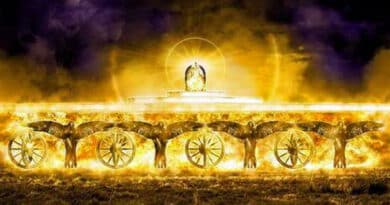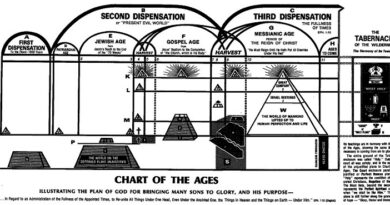
“Afterlife” in Biblical View – Part 3
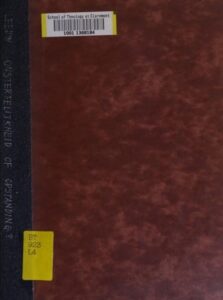 | 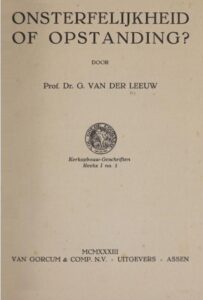 |
Gerardus van der Leeuw, Onsterfelijkheid of Opstanding (Immortality or Resurrection), Van Gorcum & Comp, Assen, Nederlands, 1933, pp. 20, 30, 32, 36:
[Innate] Immortality is a conception which fits into the philosophy of pantheism. With death belongs not immortality, but Resurrection.
The Church has – no matter how much Hellenized it may be in doctrine and practice-always maintained the resurrection of the body…. The body dies, death is not being denied at all. Even the Spirit, the soul that I am, will not exist. The soul will also die. But the whole life of man will be renewed by God. God will raise me up ‘in the latter day.
Many preachers of recent times are rather hesitant to preach about immortality. But in former days, when preaching about eternal life, it was without effort that they dwelt upon imaginations of a corruptible body and an immortal soul. The older devotional books and church hymns are full of it. Even now people in the house of bereavement and on the graveyards are being comforted from the same source – yet these representations are not in any respect Christian, but purely Grecian and contrary to the essence of Christian faith.
God alone is immortal (1 Tim. 6:16). To man he has given the promise of Resurrection… Creation will change into re-creation. And re-creation is resurrection, a raising up by God.

James S. Stewart, A Man in Christ: the Vital Elements of St. Paul’s Religion, Harper & Row – Publishers, New York, USA, 1935, p. 267:
“Now to Greek minds, the whole conception of a resurrection was strange and novel and puzzling. The first natural reaction of a Greek to the new idea would be to ask, “With what body do they come?” Philosophy had taught the Greek to believe in a purely spiritual immortality, without a body of any kind. Wise men regarded the body as a tomb in which the living spirit lay buried: σῶμασῆμα, they used to say. Death was the imprisoned soul’s escape. But Paul could not thus conceive a realm of disembodied spirits. To him, the very idea would have been repugnant: witness the earnestness of his desire that he should ‘not be found naked’ after death, but ‘clothed upon with our house which is from heaven.’ The real point at issue, of course, as Paul saw very clearly, was the continuance of personal identity. Some sort of body there must be, if the soul’s essential individuality was to survive.”
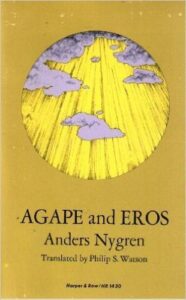
Anders Theodor Samuel Nygren, Agape and Eros, a two-volume work, first published in Swedish 1930–1936. It was translated to English in a single volume by Philip S. Watson, in 1953 (this cover is from 1969 edition), pp. 224, 225 (English edition):
When Plato speaks of the soul, the thought of the immortality of the soul is always present. Immortality is a natural endowment of the soul, which bespeaks its Divine origin. All that is required is that the soul should purify itself and set itself free from its bondage to sense in order to return to its Divine origin. The Divine life of immortality is its normal condition. This idea of the natural immortality of the soul is completely foreign to the Agape motif. Instead we find a belief in the resurrection of the dead. In the course of history these two – belief in the immortality of the soul and belief in the resurrection of the dead – have constantly been blended together; yet in fact they belong to two opposite religious and ethical worlds. Wherever the natural immortality of the soul becomes the fundamental religious dogma, we can be fairly certain that we are within the sphere of Eros. But where the Agape motif is dominant, it regularly expresses itself in belief in the resurrection of the dead. If participation in the eternal life of God is possible far man, the possibility is not based on any natural quality or endowment of man, but simply and solely on a mighty act of God. Just as it is God who makes the sinner righteous, so it is God who makes the dead to live. Resurrection is the sign-manual of the Divine Agape. It has nothing to do with the contrast between soul and body, as if one part of man’s being were by nature divine and immortal while the other was impure and perishable. Death is the judgment of God upon human life in its entirety, and resurrection is the renewal of human life, likewise in its entirety, by God’s love.
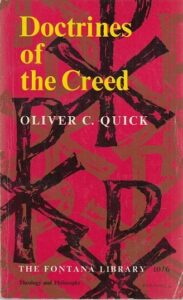
Oliver Chase Quick, Doctrines of the Creed – Their Basis in the Scripture and Their Meanings Today, New York, USA, 1938 (this cover is from 1963 edition), pp. 264-266:
3. THE TEACHING OF THE BIBLE ON LIFE AFTER DEATH
Having made this distinction clear, we turn to the teaching of the Bible. Its most obvious feature perhaps is the lack of any positive information as to what happens to the human soul when the body dies. In the Old Testament indeed there are many passages which roundly deny that the human soul continues after death in any life worth having. And even the New Testament, for all its emphasis on the glorious hope of resurrection, gives no kind of answer to the questions asked by those who are interested in spiritualism or what is commonly called “psychical research”.
Why is there at first so much negation, and at last so little information, in the Bible? The question has deeply perplexed sincere Christians who long for some definite knowledge about the condition of dear ones departed.
… From first to last the Bible is chiefly concerned to teach us that our faith and hope must be in God, that it is on God’s Kingdom, not on personal survival and its particular phases and circumstances, that our aims and affections should be set.
Already in the Old Testament it is very significant that when the psalmists deny most explicitly any value to the life of the departed spirit, they immediately pass on to declare that just for that reason their hope is more firmly fixed on God. There seems to be good reason for thinking that the picture of Sheol as a prison for unsubstantial wraiths, a picture which represents the orthodox belief of Israel before the Captivity, was originally intended to discourage a false spiritualism or cult of departed spirits which led men away from the worship of Jehovah. It was to Jehovah’s seers and prophets, not to the witches and wizards who professed to raise the ghosts of the dead, that the loyal Israelite should go for guidance. It was when Saul could get no answer from God through prophets, dreams or divination, that he turned in despair to the witch of Endor. Only after the Captivity, when idolatry and necromancy have ceased to be dangers, do we find a new hope of the after-life taking shape dimly in the Hebrew mind. And this new hope is based wholly on the all pervading presence and power of Jehovah. The faith is at last dawning that never and nowhere in the universe can the faithful be really “cut away from God’s hand”, not even by death or the bars of Sheol itself. “Though I walk through the valley of deep darkness, I will fear no evil; for thou art with me.”
In the New Testament Christ’s reply to his Sadducean questioners carries on the same line of teaching. That there is life beyond the grave, he tells them, is proved when God says to Moses, “I am the God of Abraham, Isaac, and Jacob”; for God is not the God of the dead, but of the living. In other words, a man has abiding life, in so far as the living Jehovah is really his God. For God’s faithful servants, therefore, there can be no imprisonment or empty existence among the shades. For “the gates of Hades” (or the bars of Sheol) do not prevail against the life and fellowship of God’s own ecclesia. This is the great conclusion which the Bible reaches. The immortality of man is the gift of the living God who conquers death. Of that the Bible assures us; but it does not answer our questions about what happens to the soul when the body dies. And it would be difficult to cite any text outside the Apocrypha which suggests that the soul of man is by the necessity of its own created nature immortal.
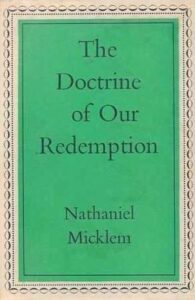
Nathaniel Micklem (1888-1976), The Doctrine of Our Redemption, Taylor & Francis, London, 1943 (This cover is from 1960 edition):
The immortality of the soul is a Greek doctrine; it is not biblical. The Hebrews and the Christians spoke of resurrection. That is the language, not of survival, but of victory… Thoughtless people often surmise that they will survive death and hope that, if they do, they will find existence somewhat less trying beyond the grave… We are apt to argue that Christ’s resurrection, if we can believe it, assures us of our own survival. But that is to see in Christ’s resurrection little more than the return of Lazarus from the grave. It is to fall far short of the triumphant conviction of the early church that Christ had won the victory not merely over physical death but also over sin and despair and every kind of spiritual bondage.
– pp. 78, 79.
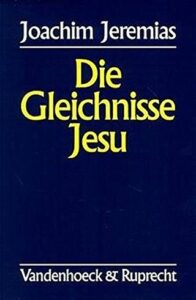
Joachim Jeremias, Die Gleichnisse Jesu [The Parables of Jesus] Zwingli Verlag, Lübbenau, Germany, 1947.
In order to understand the parable [of the Rich Man and Lazarus] in detail and as a whole, it is essential to recognize that the first part derives from well-known folk-material concerned with the reversal of fortune in the after life. This is the Egyptian folk-tale of the journey of Si-Osiris, the son of Setme Chamois to the underworld; which concludes with the words: ‘He who has been good on earth will be blessed in the kingdom of the dead; and he who has been evil on earth will suffer in the kingdom of the dead.’ Alexandrian Jews brought this story to Palestine, where it became very popular as the story of the poor scholar and the rich tax-collector Bar Ma’jan. That Jesus was familiar with this story is proved by the fact that he has used it in the parable of the Great Supper (see pp. 178 ff.). There we have already related the beginning of the story: how the scholar’s funeral was unattended, while the publican was buried with great pomp. Here is the end of the story. One of the poor scholar’s colleagues was allowed to see in a dream the fate of the two men in the next world: ‘A few days later that scholar saw his colleague in gardens of paradisal beauty, watered by flowing streams. He also saw Bar Ma’jan the publican standing on the bank of a stream and trying to reach the water, but unable to do so. V.19: The rich man, who had no need to work, feasted every day, arrayed in a costly mantle of purple wool, with underwear of fine Egyptian linen. The lack of emphasis on his guilt, although, as his fate shows, he is represented as an impious reveler, is explained by the fact that Jesus was drawing on material which was well known to his hearers. V. 20: Lazarus is the only figure in the parables who is given a name; the name (God helps) thus has a special significance. Lazarus is a cripple (ἐβέβλητο = reme = “thrown down, lying”), suffering from a skin-disease (v. 21b). As a beggar (πτωχοῖς cf. John 13.29) he has his pitch in the street, at the gate of the rich man’s mansion where he begs for a gift from the passers-by. V. 21: ἐπιθυμῶν with the infinitive, in Luke always indicates an unfulfilled desire: ‘he would gladly (if he could) have filled himself’… πίπτειν = nephal, semitic avoidance of the passive: ‘to be thrown’. Hence it shoud be translated: ‘what was thrown on the ground by those who sat at the rich man’s table’. We are not to think of ‘that which fell from the rich man’s table’ as ‘crumbs’, but as pieces of bread which the guests dipped in the dish, wiped their hands with and then threw under the table. How gladly would Lazarus have satisfied his hunger with them. The dogs are wild, roaming street-dogs who cannot refrain from nosing the helpless, scantily-clad cripple. According to the outlook of late Judaism, his miserable condition would have indicated that he was a sinner being punished by God. Hence the sequel must have been wholly unexpected by the audience. V. 22: Εἰς τὸν κόλπον Ἀβραάμ is a designation of the place of honour at the heavenly banquet at the right hand of Father Abraham (cf. John 13.23); this place of honour, the highest that could be hoped for, indicates that Lazarus occupies the highest place in the assembly of the righteous. He has experienced a complete reversal of fortune: on earth he saw the rich man seated at his table, now he himself is entitled to sit at the festal board; on earth he was despised, now he enjoys the highest honour. He has discovered that God is the God of the poorest and most destitute… the funeral of the rich man was, as the folk-material mentioned above shows, a magnificent affair. Vv. 22-31 are not concerned with the final fate, but with the state immediately after death. That is apparent from a comparison with the folk-tale on which Jesus was drawing, and is confirmed by the use of the word ᾅδῃς (v. 23); since the New Testament draws a sharp distinction between the intermediate state of ᾅδῃς and the final γεέννῃ. Hence it is the intermediate state which is in question here. V. 23: It is a common late-Jewish conception that the righteous and the wicked can see one another in the intermediate state. V. 24: The rich man appeals to his kinship with Abraham, that is, to his share (by right of descent) in the vicarious merit of Abraham. His modest request shows how terrible was his torture: a single drop of water on his tongue from the springs which flow through the abode of the righteous would be an alleviation of his suffering. V. 25: His kinship with Abraham was acknowledged (τέκνον), but not as entitling him to salvation. According to the wording of v. 25 it might appear as though the doctrine of retribution which is here expounded is of purely external application (on earth, wealth, in the life beyond, torment; on earth, poverty, in the next life, refreshment). But, quite apart from the contradiction in the context (vv. 14 f.), where has Jesus ever suggested that wealth in itself merits hell, and that poverty in itself is rewarded by paradise? What v. 25 really says is that impiety and lovelessness are punished, and that piety and humility are rewarded; this is clearly shown by comparison with the folk-material made use of by Jesus. Since the material was well known, Jesus only suggests, without elaborating the picture, the condition of the two men, on the one hand by the use of name ‘Lazarus’ which means ‘God helps’, see on v. 20, and on the other hand by the prayer in vv. 27 ff., in which the rich man reveals his impenitent state. V. 26: The ‘gulf’ expresses the irrevocability of God’s judgement; hence Jesus knows no doctrine of purgatory. V. 27: πέμψῃς suggests an appearance of the dead Lazarus ‘perhaps in a dream or in a vision’. V. 28: Διαμαρτύρηται meaning ‘to adjure’ (viz. with reference to retribution after death). V. 31: Ἀναστῇ introduces the climax. Hitherto it was only a question of an appearance of the dead Lazarus, ‘perhaps in a dream or a vision’, now the idea actually emerges of his bodily resurrection. Even so great a marvel, transcending all the daily evidences of God’s power, leaves men unimpressed who will not ‘hear Moses and the Prophets’, i.e. who will not obey them. The reference to ‘Moses and the Prophets’ as the substance of revelation (vv. 29,31) is pre-resurrection (this also holds good for Luke 13.28); the expression does not exclude obedience toward Messianic revelation , but rather, as is shown by Luke 24.27, 44, includes it, since this brings the revelation in the Law and the Prophets to its fulfilment (Matt. 5.17).
The parable is one of the four double-edged parables. The first point is concerned with the reversal of fortune in the after life (vv. 19-26), the second (vv. 27-31) with the petition of the rich man that Abraham may send Lazarus to his five brethren. Since the first part is drawn from well known folk-material, the emphasis lies on the new ‘epilogue’ which Jesus added to the first part. Like all the other double-edged parables, this one also has it stress on the second point. That means that Jesus does not want to comment on a social problem, nor does he intend to give a teaching about the after-life, but he relates the parable to warn men who resemble the brothers of the rich man of the impending danger. Hence the poor Lazarus is only a secondary figure, introduced by way of contrast. The parable is about the five brothers, and it should not be styled the parable of the Rich Man and Lazarus, but the parable of the Six Brothers. The surviving brothers, who have their counterpart in the men of the Flood generation, living a careless life, heedless of the rumble of the approaching flood (Matt. 24.37-39 par.), are men of this world, like their dead brother. Like him they live in selfish luxury, deaf to God’s word, in the belief that death ends all (v. 28). Scornfully, Jesus was asked by these skeptical worldlings for a valid proof of a life after death, if they were to be paying heed to his warning. Jesus wanted to open their eyes, but to grant their demand would not be the right way to do so. Why did Jesus refuse it? Because its fulfilment would have been meaningless; even the greatest wonder, a resurrection, would be in vain. He who will not submit to the Word of God, will not be converted by a miracle…The demand for a sign is an evasion and a sign of impenitence. Hence the sentence is pronounced: ‘God will never give a sign to this generation’ (Mark 8.12).
– The Parables of Jesus, Second Revised Edition in English, SCM Press Ltd., New Jersey, USA, 1972 (based on the 8th German edition, Vandenhoeck & Ruprecht, Gottingen, Germany, 1970), pp. 183-187.
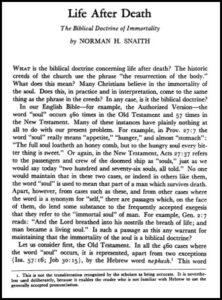
Norman Henry Snaith, Life After Death – The Biblical Doctrine of Immortality, Interpretation: A Journal of Bible and Theology, Vol 1, nº 3, July, 1947:
What is the biblical doctrine concerning life after death? The historic creeds of the church use the phrase “the resurrection of the body.” What does this mean? Many Christians believe in the immortality of the soul. Does this, in practice and in interpretation, come to the same thing as the phrase in the creeds? In any case, is it the biblical doctrine?…
Neither here nor anywhere else in the Bible is there any suggestion of an immortal soul which survives death. Nothing survives unless it be raised up by God, and the condition is that the man must be ‘in Christ’ and so ‘born of the spirit.’”.
– pp. 309, 324.
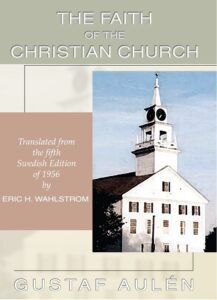
Gustaf Aulén, The Faith of the Christian Church (translated from the Swedish by Eric Wahlstrom and Everett Arden). The Muhlenberg Press, Philadelphia, USA, 1948 (this cover is from 2002 edition).
When the argument relating to condemnation and annihilation is examined, it is evident at the outset that the discussion all too often rests upon postulates foreign to Christian faith, especially the theory maintaining that the “immortality of the soul” is something axiomatically given. This line of thought, which has emanated from a philosophical and idealistic matrix, stands in sharp contrast to the characteristic viewpoint of Christian faith. For Christian faith ‘eternal life’ is not a self-evident prerogative of man, but is rather a gift which is given in and with man’s fellowship with God and is realized in and through the “resurrection.”
… It is entirely outside the sphere of systematic theology to make decisions in regard to those historical and exegetical questions which are connected with the resurrection faith of the first disciples, or with the empty tomb, or with the manner in which Christ made himself known to his own. Theology can state only that, according to the evidence, different conceptions of how the resurrection took place were current in primitive Christianity. Sometimes it is asserted that the risen Christ appeared to his own in virtually the same form as in the days of his flesh, and at other times it is said that one body is buried in the earth an another, a spiritual organism, arises (I Cor. 15). Paul does not conceive of a continued bodily existence of the same nature as the earthly. But in neither case do we find a purely spiritualized conception. It is evident that the primitive Christian resurrection faith is of a different nature from the philosophical doctrine which regards the ‘soul’ as immortal in itself, and immortality as the liberation of the soul from the prison house of the body. Such a distinction between ‘soul’ and ‘body’ is absolutely foreign to the resurrection faith of the early church. It is evident that in the New Testament we meet various ideas of the manifestation of the risen Christ, but it is also evident that the disciples regarded him as having a certain “corporeality,” however spiritualized and “transfigured” this might have been. These ideas emphasize the contrast to the philosophical and idealist conception of immortality.
– pp. 154, 220.
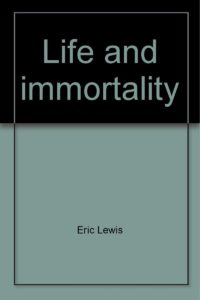
Eric Lewis, Life and Immortality, 1949 (This cover is not the real cover of the book):
1. That man is mortal. That immortality is not his by nature, but a gift of God to him in Christ, conditioned on faith and obedience, the earnest of which immortality, is the indwelling Spirit of God. And his immortality is put on at the resurrection.
2. That at death, man’s soul, his physical organism, dies, and that man returns to dust.
3. That at death, his spirit, which is not a personal entity apart from his body, returns to God who gave it, while the man himself passes into unconscious sleep until the resurrection.
4. That at resurrection, God calls the dead man back to life, breathing into Him again His Spirit … The resurrection body, given to the righteous at the coming of Christ, will be a spiritual body, a glorified body, like His own after His resurrection.
5. There will be a resurrection unto judgment, as well as unto life. Those whose names are not found written in the book of life, will be cast into the lake of fire, there to perish ultimately, burned up like the chaff. How long their suffering will last, is known to God alone; His judgment will be according to the deeds of each. This is `the second death,’ from which there will be no resurrection.
– p. 79.
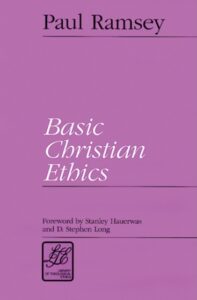
Robert Paul Ramsey, Basic Christian Ethics, Westminster John Knox Press, 1950 (this cover is from 1993 edition).
The third image of God, immortality, man possesses neither by creation nor by acquirement. Man is not inherently immortal, as he is now inherently rational and as he was completely happy as long as he remained obedient. Immortality comes as an eschatological gift, always more God’s possession than man’s even when it is given him.
… In the first place, from viewing man as a theological animal we are driven to regard all truly human worth as derivated, not inherent. Christian interpretations of man’s dignity affirm something about man in relation to God, not just something about man per se. The Platonic doctrine of the inherent, substantial immortality of the soul endowed the soul with such power of outwearing bodies as to amount to divinity, and the early Christians quite properly regarded this viewpoint as a species of robbery of God. The same is true of many of our notions of the inherent sacredness of human personality. For the Christian both ‘the immortality of a mortal’ and his personal worth are derivative, derivative from God’s appointment.
– pp. 263, 277.
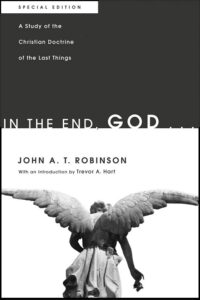
John A. T. Robinson, In the End, God…: A Study of the Christian Doctrine of the Last Things, James Clarke & Co, Cambridge, England, 1950.
The interest of modern man in Christian eschatology, if he has any interest at all, centres in the fact and moment of death. He wants to know whether he will survive it, and in what form; he wants to know what he is to expect “on the other side,” what heaven will be like, whether there is such a place as hell, and so on. But it comes as a shock to realise how foreign is this perspective, which we take for granted, to the whole New Testament picture, upon which Christianity is supposedly based.
For in the New Testament, the point around which hope and interest revolve is not the moment of death at all, but the day of the Parousia, of the appearance of Christ in the glory of his Kingdom. Moreover, this is, first and foremost, a hope not for the dead, but for the living. The doctrine of resurrection of the dead is formulated by St. Paul almost as an afterthought to meet the problem raised by that minority of Christians who had already died prior to the parousia. Indeed, life after death is one of those subjects which gains even the limited space accorded it in the New Testament writings because it had not had a central place in the original preaching and had since become a matter of controversy. But even as, whit the passage of time, the spiritual majority within the church began to pass from the living to the dead, the centre of interest and expectation continued right through the New Testament to be focused upon the Son of Man and the triumph of his Kingdom in a renovated earth. It was the reign of the Lord Jesus with all his saints that engaged the thoughts and prayers of Christians, not their own prospect beyond the grave. The hope was social, and it was historical.
But as early as the second century AD there began a shift in the centre of gravity which was to lead by the Middle Ages to a very different doctrine. Whereas in primitive Christian thinking the moment of the individual’s decease was entirely subordinated to the great day of the Lord and the final judgment, in later thought it is the hour of death that becomes decisive. It is that after which no repentance is possible, it is that which determines the destination of the soul, and it is that which supersedes the consummation of history as the main object of the believer’s concern. The traditional ‘four last things’ which stand at the end of the individual’s life (death, judgment, heaven, and hell) take the place of the great last thing, or eschaton, which doses everything.
If we ask what caused this astonishing transformation from a cosmic eschatology centering in the transformation of the universe at the last day, to an individualistic eschatology, centering in the fixing of personal destiny at the hour of death, the answer is to be found in a shift in the doctrine of God. The former eschatology derives from the Hebraic view of a God to whom time is important for the bringing to maturity of a purpose which includes and gives meaning to the whole process of history. Its climax, therefore, is the grand fulfillment of this cosmic design. The latter eschatology derives from the Hellenic view of a God to whom time is irrelevant except for bringing to perfection individual souls in and through the discipline of a material order that is itself doomed to destruction. The climax here is no longer cosmic. It comes separately for each individual at the moment when he passes from this material order. For the state in which he leaves it fixes his eternal destiny. Henceforward he is capable only of purgation, not of change or decision. For only matter and that which is in matter can change.
– pp. 24, 25 (from 2011 edition).
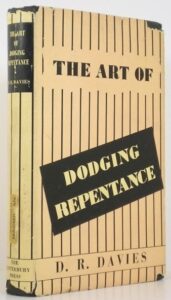
David Richard Davies (1889-1958), The Art of Dodging Repentance, Canterbury Press, Atlanta, GA, USA, 1952:
The soul of man is not necessarily automatically immortal. It is capable of being destroyed. The Bible offers no ground whatsoever for believing that the soul is immune from death and destruction. The soul can be destroyed.
The immortality of the soul is not a Biblical doctrine, but Greek philosophy. The Biblical doctrine about the soul is the resurrection from the dead. Man is a created being. God created him out of nothing. Man was created for immortality, but by his own rebellion against God he made himself mortal.
The idea of the immortality of the soul derives from Greek philosophy which conceived the after-life of Hades, a ghostly, shadowy underworld, in which the soul lived a twilight existence. We have translated the Greek word, Hades, by our English word Hell, which we think of as a place of pain and torment. But the Greek Hades was not a place of torment. Hell as torment is derived more from the Hebrew Gehenna than from the Greek Hades, which was a lower, shadowy existence, denuded of passion and suffering. It was the product of the Greek view of men as a compound of matter and soul, which death severed, releasing the soul from the prison-house of matter into an independent existence.
The Hebrew view of man was entirely different. In the Bible man is regarded as a unity of `life’ or spirit, which manifests itself as both soul and body. Since man has made himself mortal, his soul, in consequence, also partakes of mortality. Man is not a compound of two different entities, matter and spirit, but a unity of spirit functioning as matter and soul. It is this unity that is mortal.
– pp. 84, 85.
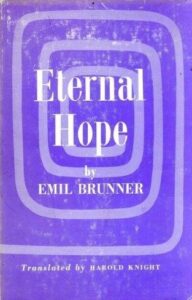
Emil Brunner, Eternal Hope, 1954:
Widely spread among all peoples and at all times is the idea of a survival of the soul after death, i.e. the view that death means the separation of soul from body. This view appears in many varied forms, from primitive animism to the philosophical doctrine of immortality. It assumes the form of the Indian teaching of Karma about the reincarnation of the soul in another life in a state corresponding to its ethical worth. Again it appears in the idea, first found in ancient Egypt, of an other-worldly judgment, in which some souls will be assigned to a joyful and radiant world, others to a dark, joyless, and tormented existence in the beyond. In such conceptions we catch a glimpse of man’s understanding of himself as a responsible person. For the history of Western thought, the Platonic teaching of the immortality of the soul became of special significance. It penetrated so deeply into the thought of Western man because, although with certain modifications, it was assimilated by Christian theology and church teaching, was even declared by the Lateran Council of 1512 to be a dogma, to contradict which was a heresy, and likewise from Calvin onwards it was assumed in post-Reformation Protestantism to be a part of Christian doctrine. Only recently, as a result of a deepened understanding of the New Testament, have strong doubts arisen as to its compatibility with the Christian conception of the relation between God and man, and its essentially pre-Christian origin has been ever more emphasized.
We consider this doctrine here only from the one point of view, that of understanding death. If the soul is immortal in the sense and for the reason which Plato and his successors teach, then the problem of death is solved because death has no power over the deeper side of man as person. We then know that we are so constructed that nothing can happen to our essential being in death. Death can affect the immortal soul as little as the waves of the tossing sea the lighthouse; it defies them by virtue of its solid construction. It remains unshaken and unimpaired. Likewise the soul. This means, however, that man and time do not belong essentially together; the true man, the noble part of man, is timeless, only his baser and lower part, his corporeality and sensuality, are a prey to death. The body is mortal, the soul immortal. The mortal husk conceals this eternal essence which in death is freed from its outer shell.
That this dualistic conception of man does not correspond to the Christian outlook can be shown from various angles. The contrast stands out most clearly in the two following points. The effect of this Platonic dualism is not merely to make death innocuous but also to rob evil of its sting.
Just as death affects only the lower part of man, so also does evil. The latter consists only in the sensual and impulsive. I myself am not truly responsible for evil 5 only my baser part, which is as it were fastened on to my better higher and true being. Evil is thus no act of the spirit, no rebellious revolt of the ego against the Creator, but merely a sensual or impulsive nature which has not yet been tamed by mind. In brief, evil is the absence of mind, not sin. Evil is not revolt, contradiction, but merely lack of education. It has no relation to God and His Will, it is a merely immanent thing, a misunderstanding which at present exists between my lower chaotic life of impulse and the formative power of my mind.
My higher spiritual life, on the other hand, is akin to God, a spark of the divine fire, logos emanating from the divine logos, consubstantial with God. The second aspect of the contrast to the Christian view is as follows. Man in his spiritual and higher being is divine, not creaturely. God is not His creator, God is the all of which the human spirit is but a part, Man is a participator in the divine in the most direct and literal sense. Hence, since this mode of robbing evil of its sting runs necessarily parallel with the rendering innocuous of death through the teaching about immortality, this solution of the problem of death stands in irreconcilable opposition to Christian thought. One believes either in the immortality of the soul and it is only necessary to believe so long as one has not mastered the proof immortality being essentially demonstrable or one believes in the God of revelation.
– pp. 100, 101, 105-107.
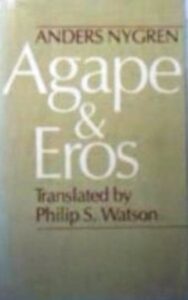
Anders Theodor Samuel Nygren (1890-1978), Agape and Eros, a two-volume work, first published in Swedish 1930–1936. It was translated to English in a single volume by Philip S. Watson, in 1953:
When Plato speaks of the soul, the thought of the immortality of the soul is always present. Immortality is a natural endowment of the soul, which bespeaks its Divine origin. All that is required is that the soul should purify itself and set itself free from its bondage to sense in order to return to its Divine origin. The Divine life of immortality is its normal condition. This idea of the natural immortality of the soul is completely foreign to the Agape motif. Instead we find a belief in the resurrection of the dead. In the course of history these two – belief in the immortality of the soul and belief in the resurrection of the dead – have constantly been blended together; yet in fact they belong to two opposite religious and ethical worlds. Wherever the natural immortality of the soul becomes the fundamental religious dogma, we can be fairly certain that we are within the sphere of Eros. But where the Agape motif is dominant, it regularly expresses itself in belief in the resurrection of the dead. If participation in the eternal life of God is possible far man, the possibility is not based on any natural quality or endowment of man, but simply and solely on a mighty act of God. Just as it is God who makes the sinner righteous, so it is God who makes the dead to live. Resurrection is the sign-manual of the Divine Agape. It has nothing to do with the contrast between soul and body, as if one part of man’s being were by nature divine and immortal while the other was impure and perishable. Death is the judgment of God upon human life in its entirety, and resurrection is the renewal of human life, likewise in its entirety, by God’s love.
– pp. 224, 225 (English edition).
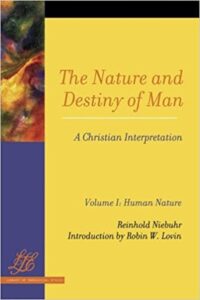
Karl Paul Reinhold Niebuhr (1892–1971), The Nature and Destiny of Man, Scribners, 1955, (Gifford Lectures at Edinburgh, 1939):
“the concept of an immortal mind in a mortal body remains unknown to the end.”
“Origen’s Platonism completely destroys the Biblical sense of the unity of man.”
“Gregory’s (of Nyssa) thoroughly Platonic conception of the relation of the soul to the body is vividly expressed in his metaphor of the gold and the alloy.”
“The idea of the resurrection of the body is a Biblical symbol in which modern minds take the greatest offense and which has long since been displaced in most modern versions of the Christian faith by the idea of the immortality of the soul. The latter idea is regarded as a more plausible expression of the hope of everlasting life.”
“The resurrection is not a human possibility in the sense that the immortality of the soul is thought to be so. All the plausible and implausible proofs for the immortality of the soul are efforts on the part of the human mind to master and to control the consummation of life. They all try to prove in one way or another that an eternal element in the nature of man is worthy and capable of survival beyond death.”
“The Christian hope of the consummation of life and history is less absurd than alternate doctrines which seek to comprehend and to effect the completion of life by some power or capacity inherent in man and his history.”
– Vol. 1, pp. 5, 7, 13, 153 [footnote], 172; Vol. 2, pp. 294, 295, 298.

John Olof Cullberg (1895-1983), docent of philosophy of religion, Doctor of Divinity and a luteran bishop in the Church of Sweden (Diocese of Västerås, Uppsala):
“The nature of man does not account for the belief in the resurrection but only the sovereign creative power of God’s love gives us the assurance of a life after death. There is nothing in me which deserves to survive death. In itself my soul is as mortal as my body. But the eternal life, which God even here can create in my heart, encircles the promise of a new, personal existence, which does not know of death and corruption, a life in eternal communion with God and those whom His unfathomable love has saved. Thus also rings the resurrection faith in the apostolic words: “For I am persuaded that neither death, nor life… shall be able to separate us from the love of God, which is in Christ Jesus our Lord.”
– ‘Dogmernas Insida’, Herdabrev till Vasterds stift, 1940.
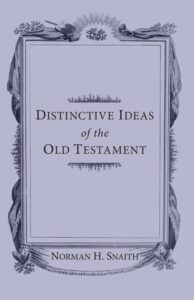
Norman Henry Snaith The Distinctive Ideas of the Old Testament, Epworth Press, London, UK, 1944. (The cover is from 1983 edition):
These [the distinctive ideas of Old Testament religion] are different from the ideas of any other religion whatsoever. In particular they are quite distinct from the ideas of the Greek religion. In particular they are quite distict from the ideas of the Greek thinkers. The aim of Hebrew religion was Da’ath Elohim (the Knowledge of god); the aim of Greek thought was Gnothi seauton (Know thyself). Between these two there is a great gulf fixed. We do not see that either admits of any compromisse. They are fundamentally different in a priori assumption, in method of approach, and in final conclusion.
Traditional Christianity has sought to find a middle way, combining Zion and Greece into what is held to be a harmonious synthesis. The New Testament has been interpreted according to Plato and Aristotle, and the distinctive Old Testament ideas have been left out of account. Here is the cause of the modern neglect of the Old Testament. The ‘righteousness’ of Aristotle has been substituted for the ‘righteousness’ of the Old Testament. The logos spermatikos of the Stoics has largely transplanted the Holy Spirit. The wholly non-Biblical doctrine of the immortality of the human soul is accepted largely as a characteristic Christian doctrine. Plato is indeed ‘divine’, and Aristotle ‘the master of them that know’…We find two passages only which speak of a resurrection life beyond the grave, and none at all of any immortality of the soul, which is not a biblical idea at all. One passage is Isaiah xxvi. 19, where the Israelite dead are to rise from the dust and live. This passage is in Isaiah xxiv-xxvi, probably early third century B.C., of the time of the rivalries of the Ptolemies and the Seleucids in Palestine. The other is Daniel xii.2 (first half of second century B.C) where we read of a partial ‘general resurrection’, ‘some to everlasting life, and some to shame and everlasting contempt’…
‘Ruach’ [spirit] as a Psychological Term to denote dominant disposition.
The idea of power involved in the word ruach [spirit] is carried over into what we would now call psychology, to denote the dominant impulse or disposition of an individual. For instance, Genesis xxvi.35 states that the two Hittite wives of Esau were ‘bitterness of spirit’ (morath ruach) to Isaac and Rebekah…
The idea of ruach standing for that in a man which so dominates him as to ensure a particular line of action is seen in the phrase, ‘I will stir up the spirit of…’ This phrase is post-exilic, being found thrice in Haggai i. 14; four times in the Chronicler, I Chronicles v. 26; 2 Chronicles xxi. 16, xxxvi. 22, with its equivalent Ezra i. I… The remaining references to the ‘spirit of a man’ are to be found in Ecclesiastes. They are vii. 9, x. 4; and in the comparison between the spirit of a man and the spirit of a beast, iii. 18-21. In this last case the spirit is regarded as being the life-centre of the body, closely allied to the ‘soul’ in the sense in which those who believe in the immortality of the soul use the word.
This latter use of ruach as the spirit of the living being makes the word practically a synonym of nephesh, the breath-soul. God forms this ruach in man, Zechariah xii. 1; preserves it, Job x. 12; and it returns to Him at death, Ecclesiastes xii. 7. In Isaiah xxvi. 9 ruach is exactly parallel with nephesh, and so also in Job vii. II. There are some twenty-five cases altogether where ruach is equivalent to nephesh.1 But to make nephesh on that account the general equivalent of ruach is to show a complete misunderstanding of the proper significance of both words. Such an equation is wrong and can lead to nothing but error and confusion.m It is only in the cases where the meaning of the word ruach approaches the outermost fringe of the circle of its meaning that the word comes into touch with the circle of ideas represented by nephesh. Such instances are late. It happens only when ruach as controlling power in man comes to mean the man himself as a determining, active entity, and when at the same time nephesh comes to mean the same thing, it also being extended, this time from its truer meaning of that which makes the difference between the living and the dead.
[NOTA:] 1) The main meaning of nephesh is to be seen in Genesis ii.7: ‘Jehovah Elohim shaped man, earth from the ground, and breathed into his nostrils life-breath (neshamah), and man became alive (nephesh).’ It is that which makes the difference between a living being and a dead one…
The Septuagint is the Bridge between the Two Testaments
The generally accepted approach to the New Testament is to insist in the first place that the New Testament is writtten in the common (Koine) Greek of the period, and forthwith to interpret much as any other Hellenistic book. This allowed for Aramaisms, Latinisms, and the like, for Hellenistic Greek varied to this extent from place to place. But mainly it involved the study of Hellenistic Greek in the inscriptions, the papyri, and in such Hellenistic writers as Polybius and Josephus. It has not involved, to any marked extent, the study of the Greek Bible, the Septuagint, which for 400 yeras was the Bible of the Christian Church.
This procedure has been sound so far as syntax and gramar are concerned, and a great step forward from the old approach whereby New Testament Greek was compared with classical Greek, weighed in the balances, and found wanting. To have studied the grammar and the syntax of Septuaging would have been worse than useless, since Septuagin is largely translation Greek. But the neglect of the Septuagint from the point of view of the meaning of the words has been serious. It is becoming more and more clear, thanks to such studies as Dr. C. H. Dodd’s The Bible and the Greeks that considerable attention must be made to the way in which the Septuagint translators rendered the Hebrew words. The Greek word in the Septuagint tends to carry the meaning of the original Hebrew word, and not its own meaning as a normal Greek word. In many cases, perhaps in most cases, the neglect of this distinction is of little account, and entails no serious error. But the cases where it does make a very great deal of difference are precisely those cases where we are dealing with the distinctive ideas of the Old Testament. These ultimately are the only cases that matter… It is essential, especially if the word in question is a religious word, to begin with Septuagint, and to notice to what extent Septuagint used the word as the equivalent of the original Hebrew, and next to see to what extent the New Testament usage in any writer is covered by this Septuagint use, and then to examine to what extent, as e.g. Paul in the case of nomos-torah, the Greek usage also is involved.
The extent to which the Greek of the Septuagint is really Hebrew-Greek has not been recognized in time past as it ought to have been recognized. Particularly is this so, since the medium through which Old Testament ideas came to the Christians in the first place was Greek. We are of the opinion that incalculable harm has been done by this neglect. It began very early. The confusion appears as early as Clement of Alexandria and Origen, and it arose from the fact that these scholars were Hellenists first and Christians second. It was furthered by the fact that all men until Jerome, tended to read the Greek Bible as a Greek book, and with Hellenistic eyes. This lasted till the fifth century, and both learned and unlearned were equally at fault. They interpreted the words as Greek words, just as if Greek had been the original tongue. Later this was done for centuries with the Latin Bible, and it has been the fate of the Bible in every language into which it has been translated. The result of this has been that from a very early stage, Christianity itself has tended to suffer from a translation out of the Prophets and into Plato. Later the master was Cicero, and with the Renaissance, Aristotle. Plato has indeed been made to be ‘divine’, and Aristotle ‘the máster of them that know’. The tragedy of Christian theology through the years is the extent to which these statements are true in the matter of ‘knowing Christ’. The Reformation was na attempt to restore the original Hebrew setting of the Gospel, and, theologically, to break the shackles of the Greeks. The Revival of classical learning was a reshackling of the Faith, to which many of the Reformers themselves succumbed…
It is generally agreed that in his antithesis between pneuma (spirit) and sarx (flesh), Paul is dependent upon Old Testament ideas, as also for his whole concept of the constitution of man. Paul makes a sharp contrast between the things of God and the things of man. In this distinction he is true to the Old Testament tradition of the ruach-adonai as that Power of God which descends upon a man, changes his heart and spirit, gives him new life and, in New Testament phrase, makes him a child of God. We do not propose to enter into a detailed discussion of the use and meaning of the term ‘Holy Spirit’ in the writings of Paul, but only with reference to the particular point of the relation between the ‘soul’ (psyche) and the pneuma (spirit) of man on the one hand, and the Spirit of God on the other. Here mostly we find, during the centuries of Christian interpretation, a marked tendency erroneously to interpret the Pauline material in a Greek rather than in a Hebrew framework.
The Spirit of Man
Paul certainly uses the word pneuma of the spirit of a man, e.g. Romans i.9, ‘whom I serve in my spirit…’, and Galatians vi. 18, ‘The grace of our Lord Jesus Christ be with your spirit, brethren.’ Parallel to the cases, and more significant, since these two cases concern converted men, is I Corinthians ii. II: ‘For who among men knoweth the things of a man, save the spirit of a man, which is in him?’ Origen held that the word pneuma (spirit) here includes both intellect and conscience, but it is better not to define the precise meaning more than to say that Paul is referring to the controlling, directive power in man. Particularly we regard it as unfortunate that the conscience should be introduced here, since the conscience is a human faculty, included in the psyche (‘soul’) and not in pneuma (spirit). We therefore deprecate such an interpretation as ‘man’s entire intellectual and moral nature’, since Paul is thinking in terms of the Hebrew ruach (spirit) rather than of Plato’s ho entos anthropos (the inner man).
Paul’s main use of the word pneuma as the spirit of man is in definite contrast to the Spirit of God, this being, as we have indicated, an inheritance from the Old Testament. The distinction is very clear in I Corinthians ii. Here it is the Spirit of God who reveals the true wisdom of God to men. These things of God are received by the spiritual (pneumatikos) man, and not by the ‘natural’ (psychikos) man – that is, not by the human faculties. Man as man cannot know these things. They are not within the sphere of the ‘soul’ (psyche). It is clear from this that Paul does not use the word psyche either in the Homeric sense of that which survives death or the sense of the Greek philosophers as the immortal soul or spirit of man…
We find this approach of the Greeks no where in the Bible. The whole Bible, the New Testament as well as the Old Testament, is based on the Hebrew attitude and approach. We are of the firm opinion that this ought to be recognized on all hands to a greater extent. It is clear to us, and we hope that we have made it clear in these pages to others, that there is often a great difference between Christian theology and Biblical theology. Throughout the centuries the Bible has been interpreted in a Greek context, and even the New Testament has been interpreted on the basis of Plato and Aristotle. This may be justifiable, but we hold that those who adopt this method of interpretation should realize what it is that they are doing, and should cease to maintain that they are basing their theology on the Bible.
– pp. 9, 89, 146-148, 159-161, 183-185.
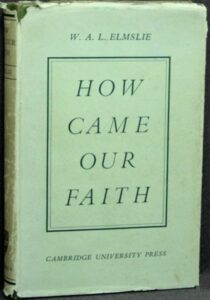
William Alexander Leslie Elmslie, How Came Our Faith: a Study of the Religion of Israel and Its Significance for the Modern World, Charles Scribner’s Sons, New York, USA, 1948 (This cover is from 1950 edition, Cambridge University Press):
When a man dies, what happens? Obviously, for the Hebrew thought his nephesh no longer exists; for that word signified only the Being caused by the coexistence of animating breath with flesh, bones and blood. His dead body of flesh and blood must be buried in the grave, and so returns to the dust of the earth. His breath-vitality (ruach or neshamah) returns to God who gave it.
– p. 124.
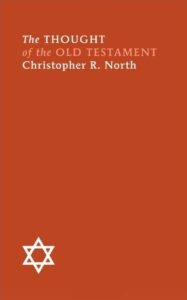
Christopher North, The Thought of the Old Testament, Epworth Press, England, 1948 (This cover is from 2009 edition), Wipf & Stock Publishers, Eugene, Oregon, USA):
… it was not until after the exile that the problem of the unmerited sufferings of individuals began seriously to engage the attention of Jewish thinkers… It would seem that the first explicit statements that this present is not the only life arose out of attempts to relate the fortunes of individual Jews to the blessedness of the expected Kingdom of God. In two Old Testament passages, one of which is certainly, and the other probably, as late as the second century B.C., it is said that individuals will live again to share in the blessings of the Kingdom. One is Isaiah 26:19, which, in comparison with verse 14 of the same chapter, asserts that individual Jews will live again, whereas the godless heathen will not. The other is Daniel 12:2, where the implication is that righteous Jews will participate in the Kingdom, that the conspicuously ungodly will rise also, but to shame and everlasting contempt, while those who have been neither good nor bad are presumably to remain in Sheol. The details, you observe, are different; but both passages agree in speaking of a resurrection from the dead. That is the direction which, on Old Testament premises, anticipation of the life to come inevitably took. We have seen that the Old Testament did not think of man as an incarnated immortal soul, but as an animated body; that the body, for it, was an essential constituent in human personality. Hence, when the Jews did at last come to believe in life after death, they spoke in terms of the resurrection of the body, not (in Greek fashion) of the immortality of the soul. This is, historically, the reason why, when we recite the Apostles’ Creed, we say, not, ‘I believe in the immortality of the soul,’ but, ‘I believe in the resurrection of the body’. I am naturally tempted, of course, to argue the case as between the Greek and the Jewish-Christian conceptions; and I have no doubt that you would like me to. But that is a theme which lies outside the province of these brief lectures. I will content myself with one relevant observation, and that is that according to the thought of the Old Testament any life to come is of God’s grace, not an inalienable portion of human nature.
– pp. 56, 57.
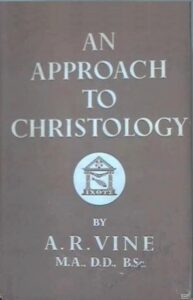
Aubrey Russell Vine (1900–1973), An Approach to Christology, Independent Press, 1948:
‘Immortal’ should not be applied to a human spirit if we clearly recognize that it is only immortal at God’s grace and pleasure. Only God is immortal by His own nature and without qualification.
The natural immortality of the spirit is a Greek rather than a Christian concept.
Against the idea of the natural immortality of the spirit we must set the fact that God is the only self-existent and that nothing exists or continues to exist except by His grace and will, within this schema or within any other. God only is exoschematic. When we use the word `immortal’, therefore, of anything but God, we must always realize that none but God is immortal by his own nature and without qualification.
Man is not a spirit inhabiting a body. He is a spirit naturally integrated into a body, which is a very different matter. While a man lives he is not a spirit: he is a man, and ‘man’ includes body just as certainly as it includes spirit. He is a complex, and he reacts as a complex, though that complex is a natural unit and therefore acts as a unit.
– pp. 311 (footnote), 314, 315, 322.
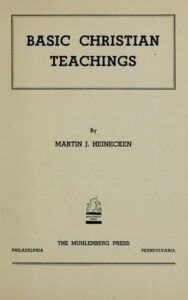
Martin J. Heinecken (1902-1998), Basic Christian Teachings, Muhlenberg Press, Philadelphia, USA, 1949:
In the Biblical account of creation we are told that God formed man of the dust and of the earth, and that he then breathed into his nostrils and man became a living soul. This is usually interpreted to mean that God made a soul, which is the real person, and that he then gave this soul a temporary home in a body, made of the dust of the earth. But this is a false dualism or twoness. The Bible does, as we shall see, speak of a twoness in man; it is that of the old, natural man and the new man in Christ. This is quite different from a dualism of mind and matter or soul and body. Man must be considered a unity…
We are dealing with a unified being, a person, and not with something that is called a soul and which dwells in a house called the body, as though the body were just a tool for the soul to employ, but not really a part of the person – as though you could divorce the look in a person’s eyes, or the tone of his voice, or the pressure of his hand, from the real person…
Immortality of the Soul
By way of contrast with this changing and disintegrating world of things it is held there is within every man an unchanging and indestructible core, immortal in its own right. It is unaffected by time; it had no beginning, neither can it have an end. It has always been and always will be. It came into this world of changing things from the realm of eternity and will return to it. Views vary as to just how and when this will take place. Usually it is a long process of gradual liberation from the world of things, sometimes through sucessive reincarnations, sometimes through higher and higher realms of being, to eventual perfection. Sometimes the individual soul is said to lose its identity as it merges eventually with the great world soul with which it is basically one.
Resurrection
The Christian view is by no means to be identified with the above belief in the immortality of the soul. The Christian belief is in the immortality of the God-relationship, and in the resurrection. The Christian dualism is not that of a soul and body, eternal mind and passing things, but the dualism of Creator and creature. Man is a person, a unified being, a center of responsibility, standing over against his Creator and Judge. He has no life or immortality within himself. He came into being through God’s creative power. He spends as many years on this earth as in God’s providence are allotted to him. He faces death as the wages of sin. Death is, as we said, the limit which God sets to man’s proud pretensions that he has life within himself. But it would be a great mistake if man thought that death, therefore, ends all, and that he can escape God by dying. “It is appointed unto men once to die, but after this the judgment” (Hebrews 9:27).
The prospect, therefore, is this: Through God’s power all men will be resurrected, that is, brought back from death to life, to face the judgment. This resurrection and judgment is put at the end of time. It is connected with the return of Christ in glory…
No Intermediate State
All this is put at the end of time. It happens suddenly, abruptly, simultaneously for all men. In all the words and promises of Christ, and in all the New Testament witness, there isn’t a single justification for belief in an intermediate conscious state intervening between death and the general resurrection which ushers in the reign of Christ in glory and the new heaven and the new earth. There is nothing about any purgatory in which the souls are gradually purged and made fit for heaven…
It is when man is falsely split into body and soul that the speculations concerning an intermediate state arise. They arise also from a concern about the dead who have died in the Lord and are presumably at home with him and not just asleep in their graves, waiting for the last trumpet to sound. Because this thought was intolerable, men have speculated like this: At death the soul is separated from the body. It appears then before God in a preliminary judgment (mentioned nowhere in Scripture) and enters into a preliminary state either of blessedness or condemnation. Then, when the last trumpet sounds, the body is resurrected and rejoined with the soul, and complete once more, the reunited body and soul appear for the final, public judgment scene, from there to enter into final bliss or final condemnation. It is no wonder that, with this view, men must have little use for a resurrection, and have finally dropped the notion altogether and have been satisfied with the redemption of only the soul.
The only way to cope with this is to take seriously the transition from time to eternity. Since there is nothing in Scripture about an intermediate state and a preliminary judgement, every person must be held to pass through death immediately to the one and only resurrection and judgement. When a man dies, then time is over for him. All these people who have died along the line of time, and will continue to die along it, pass at death into that other realm of eternity. This realm is not just way off in the future somewhere. It crosses ours, like the vertical dimension crosses the horizontal one. To die then means to pass to the resurrection and the judgment at the end of time. You can, if you wish, say that all men sleep until the final trumpet sounds. But what is the passage of time for those who are asleep? The transition from the moment of death to the resurrection would still be instantaneous for them. It would be no different from going to bed at night and being waked in the morning.
We should not be troubled either by the thought that loved ones who have passed on before us are not at home with the Lord. Time is over for them; they have arrived; they are not waiting. It is we who are still in time, and still on trial, and still living by faith, who are doing the waiting. The saints are at home with the Lord.
– pp. 36-38, 133-136.

Norman Snaith, I Believe In…, SCM Press Ltd., London, England, 1949:
‘AND I LOOK FOR THE RESURRECTION OF THE DEAD, AND THE LIFE OF THE WORLD TO COME.’
The creeds all speak of a resurrection and not of a survival. Mostly it is ‘of the flesh’, though here in the so-called Nicene Creed it is ‘of the dead’. There seems to be little doubt that the Church for centuries thought in terms of a rekindling of life in the actual body of flesh and bone. This was the belief of Clement of Rome and of Origen, but it was Augustine who was chiefly responsible for the establishment of the traditional belief. This belief is enshrined in the paraphrase of the Authorized Version of Job 19.25-6, which is quite clearly a declaration of the resurrection of the body, and is kept fresh in public memory by the popularity of Handel’s Messiah. Augustine said that Job ‘prophesied without doubt the resurrection of the flesh’, and he declared that the passage meant ‘I shall be in my flesh when I shall see God’. Jerome’s Latin Vulgate (contemporary with Augustine, and dated A.D. 390-405) reads: ‘And on the last day, I shall arise out of the earth. And I shall be clothed again with my skin: and in my flesh I shall see God.’ This is the rendering of the Roman Catholic official Douai Version, and it is an interpretation, rather than a translation, of the original Hebrew. Our Authorized Version has in some respects gone still further. In the original Hebrew there is nothing at all to be found about a resurrection from the dead, and this is a fact generally accepted by Hebrew scholars.
I find two passages only in the Old Testament which speak of any life after death for anybody. These are Isa. 26.19 and Dan. 12.2 [both resurrectional passages] (I take such passages as Ps. 73. 23-26 and Ps. 139. 7-10 to be geographical, as is, I think, plain in the Hebrew.) Both verses are somewhat late, and both are in apocalypses. The former passage can be dated approximately about 300 B.C., and the latter about 165 B.C. The first declares that Israel’s righteous dead will be raised up in order to partake of the blessings of the deliverance of Israel. The second says that ‘many of them that sleep in the land of dust (so the Hebrew) will awake, some to everlasting life, and some to great shame and everlasting abhorrence’. The old idea was of Sheol, the vast, roomy underground abode of the dead, all of it negative rather than positive, and to be regarded as the persistence of death rather than of life. Attempts have been made, and sometimes still are made, to see in these shadowy thoughts of Sheol the beginnings of Hebrew ideas of a real life after death. All such attempts are misguided. The Hebrew ideas of resurrection did not come from ideas concerning Sheol, just as the Greek ideas of immortality did not arise from the traditional and popular notions of Hades. For the philosopher, the idea came through Plato, whilst for the ordinary man it came much later, and then from the mystery religions with their cults of the saviour-gods.
The Hebrew belief in life after death arose from the firm conviction that God is still the Saviour of Israel, however much the nations may rage and their rulers take counsel together against the Lord and against His Anointed. There must, they believed, sometimes and somewhere, be an age of returned primeval bliss, when God shall be all in all and Israel at the head of the nations. The intense practicalness and ‘this-worldliness’ of the Jew demanded that this new world should be here on earth, a transformed earth perhaps, but certainly here and real. It would be heralded by a great Day of Judgment, and after that the life of the world to come would begin. There came a time when they began to suspect that after all the Kingdom of God might not be realized here on such an earth as this, but in heavenly places, though the idea of revived bodies never wholly died, just as the idea is still maintained among some Christians today.
The most instructive picture of what the Jews of the time of Christ (though not the Sadducees) believed to happen after death is to be found in Enoch 22 (dated about 170 B.C.). There we find an account of the threee places in Sheol where the spirits of the dead were believed to be assembled until the Day of Judgment. Between the three places great gulfs were fixed, so that any interchange was impossible. One place was for the righteous, and there they were preserved in safety until the Day of Judgment, when they were judged and entered into the bliss of the world to come which had been prepared for them. The second place was for the wicked who had suffered on earth for their sins. Nothing else happened to them. They were not raised up. They had sinned, and they had paid the penalty. That was that, and that was all. The third place was for the sinners who had not suffered on earth for their sins. This was a place of great torment; they paid the penalty for their sins. At the Day of Judgment they were judged, and destroyed.
This, as is evident, is the framework of the Dives-Lazarus story. Lazarus is in ‘Abraham’s bosom’, that is, in the abode of the righteous awaiting the Last Day. Dives is not in the hell of popular imagination, but is paying the price in Sheol for unrequited sins committed on earth. He died unrepentant, and this is where he pays. When Jesus tells the dying thief that they will be together that day in Paradise, the reference is to the abode of the righteous. His parable of the five wise and the five foolish virgins emphasizes the finality of the judgment of God which comes prior to the Messianic banquet which was supposed to usher in the Messianic Kingdom. Indeed, in every way, it is evident that Jesus spoke and thought substantially as is set forth in Enoch 22. There is a Judgment Day for the righteous and for the wicked who had not repented of suffered on earth. There is a resurrection to life for the righteous and for the wicked who had not repented or suffered on earth.
In the writings of Saint Paul, there is a sharp distinction drawn between ‘the natural (psychikos) man’ and ‘the spiritual (pneumatikos) man’. Nothing of the natural man survives into the life of the world to come, but only the spiritual man, that is, the man who is born of the spirit (pneuma). The phrase ‘natural man’ includes everything which Paul regarded as belonging to the psyche. This is the word which, in Plato and amongst the Greeks, stands for the immortal soul of man, but the word is never so used in the Greek Bible, neither in the Old nor in the New Testament. In the Greek Old Testament the word stands for the Hebrew nephesh, that livingness of appetite and desire which ceases to exist at death. In Sheol there is no nephesh, no desire, no longing, no life. This use of the Greek word psyche is carried over into the New Testament, so that nowhere at all in the English Bible should the word ‘soul’ be understood to refer to an immortal part of man which survives death. According to the Bible, there is nothing in man qua man which survives death, but if he has during life been born of the spirit, then he is raised up to be partaker in the life of the world to come.
The great difference which the New Testament makes is in the matter of merit. According to contemporary Jewish thought, a man could earn his place in the world to come by filfilling the Law. Paul makes it clear that there is no such way, but that all is of grace. What is required on man’s part is faith, a full trust on and reliance upon God.
If therefore, even in the moment of death, a sinner truly repents and trusts in God, then all is well. What was true of the dying thief can be true for every living man. And no man can say that because of what he has done, he is sure of life in heaven. We every one of us have to depend wholly upon the merits and death of the Lord Jesus Christ. Whilst it is true that faith without works is dead, the deciding factor is the faith rather than the works. The dying thief had faith, and in the nature of things he had no time in which to show any works.
But ‘how are the dead raised, and with what manner of body do they come?’ In this chapter (1 Cor. 15) Paul distinguishes between a spiritual body and a natural body. To some extent he varies from the contemporary and traditional view of the revivifying of the actual body of flesh and blood. I judge that in modern phraseology his view is: All the things which belongs to this physical life come to an end at death. This includes all emotional elements and all aesthetic and all mental qualities. But if a man is born again, if, that is, he is born of the spirit, then his ‘body’ (soma) acts as a sort of carrier, and the identity of the man is preserved. It is the same man who is raised up. The spirit persists; not a soul in the sense of something which was naturally his because he was a man, but a spirit which was born in him when he came to Christ in faith. Much the same teaching is to be found in the Fourth Gospel in respect of bios (ordinary physical life) and zoe (eternal life) is the ‘carrier’ into heavenly places. This I take to be the correct modern interpretation of the phrase in the creed.
I am quite clear myself that the biblical doctrine concerning life after death is that the final crisis takes place at death. This, as I understand the Gospels, is plain form the words of Jesus Himself, and I see no reason to suppose anything else except on a basis of wishful thinking or on the basis of some doctrine of personal merit which is excluded. This is why it is so important that sinners should be converted now, before they die. Incidentally to me, this is a final argument against hanging as a penalty for murder. It is a dreadful thing to fall into the hands of the living god, and I would not cut any man from the opportunity of repentance. No man is so wicked and so thoroughly abandoned, but that the grace of God can accomplish its saving work in his heart and life. It is clear, too, to me, that there is a resurrection to eternal life for the repentant sinner who has what our fathers used to call ‘dying faith’, that is, for those who have died in the hope of the Gospel. There may be a resurrection for the unrepentant sinner, for the Bible teaching varies here, but if there is, then it is a resurrection to damnation and death. If we do depart from this doctrine, then we should recognize quite frankly that we are departing from biblical doctrine and from the teaching of the Church of the first centuries. To me it is a most remarkable thing that the early Christian thinkers kept so very clear of the Greek doctrine of the immortality of the soul. It was there, fully developed, but they kept clear of it. I think that it is significant.
What happens to the unrepentant sinner after death? I hold that either he suffers the torments of hell, or he is destroyed at death. I incline to the latter view, because I cannot conceive that God punishes any man except to bring him to repentance. If therefore there is any punishment of the wicked after death, then it must be with the object of bringing them to repentance, and the Roman doctrine of Purgatory is substantially sound.
I find nowhere in the Bible any doctrine of the necessary survival of the individual, that is, of the immortality of the soul in the sense that there is a part of every man which can never die. It certainly is the will of God that all men should be saved. It is true now as ever it was that God ‘desireth not the death of a sinner, but rather that he may turn from his wickedness and live’. But it is also true, as this prayer implies, that if he does not repent, then he dies. God has given to man this freedom to choose, and it is a real freedom. It is, in fact, a freedom to live or to die. And not even God can have it both ways. It seems to me that it is nothing but muddled, sentimental thinking to say that if one man is lost, then God is defeated. God’s victory is a victory over sin. Sin will at the last be destroyed, and with it all that cling to it. No plant can live in poisoned soil, and sin poisons the life of a man so that the plant of the spirit can never grow there.
… If Christian men really understood the deadly poison of sin, they would take the words of Jesus more seriously and would realize that there is a terrible judgment ordained of God for all unrepentant sinners, and that a man can indeed die eternally.
– pp. 115-121.
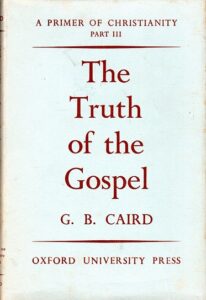
George Bradford Caird, The Truth of the Gospel: A Primer of Christianity, Oxford University Press, England, 1950 (This cover is from 1956 printing):
There are many people who believe firmly in an afterlife who would rather not be troubled with so complicated a doctrine as the resurrection of the body, particularly if they have had enough trouble with the body itself through ill health. They would prefer to believe that at death the soul leaves the body behind like an old suit of clothes and goes unencumbered to heaven. Now there is plenty of support for this belief in Greek philosophy, but none in the Bible. The Greeks believed that the body is the root of all evil – a prison in which the soul is incarcerated until its release at death. But, the Hebrews believed that the body is good, since God made it. A belief in the immortality of the soul would mean that only part of the human personality survived death. In teaching the resurrection of the body, the Bible is asserting that the whole personality survives.
– p. 122.
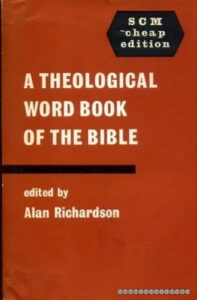
A Theological Word Book of the Bible, Alan Richardson (Ed.), The MacMillan Company, New York, USA, 1951. (This cover is from 1962 Edition):
IMMORTAL, IMMORTALITY
This is not a very common word int the Bible, since the Apostolic preaching bore witness to an event which was described as the Resurrection… and not as the survival of the soul of Jesus after bodily death. In the G[reek] doctrine of immortality the body dies, but the soul, set free from the restrictions imposes by the body, continues its life. Immortality is held to be one of the distinctive qualities of a truly human life, so that there is no real death but only a discarding of the outworn envelope of the body. ‘In the eyes of the foolish they seemed to have died’ (Wisd[om] 3.2, showing G[reek] influence). The Bible writers, holding fast to the conviction that the created order owes its existence to the wisdom and love of God and is therefore essentially good, could not conceive of life after death as a disembodied existence (‘we shall not be found naked,’ 2 Cor. 5:3), but as a renewal under conditions of the intimate unity of body and soul which was human life as they knew it. Hence death… was thought of as the death of the whole man, and such phrases as ‘freedom from death,’ ‘imperishability’ or ‘immortality’ could only properly be used to describe what is meant by the phrase the eternal or living God (v. LIFE, LIVING) ‘who only has immortality’ (1 Tim. 6:16). Man does not possess within himself the quality of deathlessness, but must, if he is to overcome the destructive power of death, receive it as the gift of God who ‘raised Christ from the dead,’ and put death aside like a covering garment (I Cor. 15:53-54). It is through the death and resurrection of Jesus Christ that this possibility for man (II Tim. 1:10) has been brought to life and the hope confirmed that the corruption (Rom. 11:7) which is a universal feature of human life shall be effectively overcome. (V. also HELL, RESURRECTION.)
– pp. 111, 112.
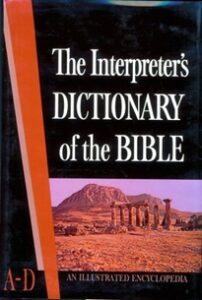
The Interpreter’s Dictionary of the Bible, George Arthur Buttrick, Abingdom Press, USA, 1952:
1. The Problem of Death. The one área which this redemption-faith of Israel had most difficulty in penetrating was that of the suffering and death of the individual man. The views of Israel regarding death were so strongly conditioned by those of her pagan neighbors, excepting Egypt, that the invasion and transformation of this realm by the new and unique theology of Israel was a slow process, completed in the intertestamental period long after the classic age had come to an end. At death man’s unity of being is destroyed and he loses vitality. The nephesh or “soul” (see above, pp. 367-68) thus does not continue to exist. It disintegrates, or as in the case of the suffering servant, it is said to be “poured out” as an offering to death (Isa. 53:12). The dead are like “water spilt on the ground, which cannot be gathered up again” (II Sam. 14:14).
This does not mean, however, that existence ceases. Man continues to live, though in a very weak state, in the underworld of Sheol, together with those who have passed into this realm before him. There he subsists in darkness (Job 10:21-22), in a kind of sleep (Nan. 3:18), in weakness (Isa. 14:10), in forgetfulness (Ps. 88:12). Existence in Sheol thus was conceived as the opposite of life. Earth is the land of light; Sheol is filled with the primordial darkness (cf. Gen. 1:2). Life means vitality and energy; death is weakness, inaction, a mere shadow of life. Since God is pre-eminently the giver of life and Lord of the living, it was something of a question to the Israelite as to what relation he had with the dead. Is not death the separation from life and thus from the God of life? Consequently, the psalmist questions whether God will show his wonders to the dead, whether his lovingkindness and his righteousness will be known in the land of forgetfulness (Ps. 88:10-12; cf. Isa. 38:18). He prays the more earnestly, therefore, to be delivered from death’s power. Many of the psalmists lived in great danger of their lives or in grave illness; and any form of weakness which robbed them of the free exercise of their powers was to them a form of death, though as yet the gates of Sheol had not closed finally upon them. Their prayers were for God to save them and to bring them back from the “pit” or from the waves of the deep through which they have been forced to go in the journey to the underworld (cf. Jonah 2:2-6). In God’s hands are the issues of life and death, for it is he who “killeth, and maketh alive; he bringeth down to Sheol and bringeth up” (I Sam. 2:6; cf. Deut. 32:39).
The dominant emphasis in the prayers of sick and troubled individuals was thus on the redemptive power of God to save them from death. The greatest boon in life is to walk with God and to dwell in his presence, for there is “fulness of joy” and “pleasures for evermore” (Ps. 16:11). The faithful man was certain, therefore, that God would redeem his life (nephesh) from Sheol’s power (Ps. 49:15; Hos. 13:14). Does this mean that death will be abolished? Such a passage as Ps. 23:6 (“I will dwell in the house of the LORD for ever”) is somewhat ambiguous and unclear. There is no doubt, however, that during the postexilic period some believers began to answer the question in the affirmative. In God’s new age there shall be no more death, and tears shall be wiped away from all faces (Isa. 25:8; cf. I Cor. 15:26, 54; Rev. 21:4). The chief difficulty which the man of faith had with death was that it separated him from life with God. Consequently, it was inevitable that sooner or later he would assert that the cause of this separation would be removed (cf. Ps. 139:8), for God in life will guide him with his counsel and afterward receive him with glory (Ps. 73:24). Illustration of the thought in the last passage was at hand in the cases of Enoch and Elijah, neither of whom suffered death but was taken directly to God’s heavenly abode (Gen. 5:24; II Kings 2:11). This made it easier for some to believe that God would send Elijah back to earth again as the forerunner of the new age (Mal. 4:5; cf. Mark 9:11-13). Yet if death is to be abolished by God in the new age so that redeemed man need never be separated from him, what about those who have died before that time? Two late passages affirm their resurrection: Isa. 26:19 and Dan. 12:2. In keeping with the unitary view of man, this doctrine of the resurrection of the dead is the only one which would be congenial to the biblical point of view. Many people under the ultimate influence of Greek thought have felt it simpler to believe in the immortality ol the soul, though from the standpoint of reason this separation of soul from body appears as difficult as the belief in the resurrection of the body, i.e., of the complete person. The later view, however, excludes all thought of a natural immortality and focuses attention upon the gracious miracle of God to raise the departed into fellowship with himself in the new age on earth. It was in this context that the doctrine became widespread in the intertestamental period, though there continued to be those who retained the position of the earlier literature of the Old Testament and who thus did not believe it (cf. Eccl. 3:20-21; and the Sadducees of the New Testament time, Matt. 22:23). Yet for the majority of the Jews the faith in God’s redemptive power had finally won its victory over death.
– Vol. I, 1952, pp. 370, 371
The traditional rendering of the Hebrew néphesh by soul led the older commentators to associate this verse [1 Sam. 25:29] with a belief in an afterlife, and this interpretation is still accepted by some modern Jews. But the idea of man as consisting of body and soul which are separated at death is not Hebrew but Greek. According to the Hebrew creation story God breathed the breath of life into Adam’s clay and he became a néphesh ḥayyāh – a living creature (Gen. 2:7). The néphesh, then, is not the soul but the life, and Abigail is promising David a long life under the protection of God. The figure is that of precious possessions wrapped up in a bundle so that they shall not be lost. It was not for many a long year after this that Israel had any intimation of immortality.”
– Vol. II, 1953, p. 1015.
“The departure of the nephesh must be viewed as a figure of speech, for it does not continue to exist independently of the body, but dies with it (Num. 31:19; Judg. 16:30; Ezek. 13:19). No biblical text authorizes the statement that the ‘soul’ is separated from the body at the moment of death.”
“… In the Old Testament man is regarded as a “psychosomatic” whole. The idea of a disembodied spirit, or a soul separated from its body, was not congenial to Jewish thought. And it was not until the Persian and Hellenistic periods that Jewish writers were able to entertain a doctrine of pre-existence of the soul.”
– Vol. I, 1962, pp. 802, 870.
“The word ‘soul’ in English, though it has to some extent naturalized the Hebrew idiom, frequently carries with it overtones, ultimately coming from philosophical Greek (Platonism) and from Orphism and Gnosticism which are absent in ‘nephesh.’ In the OT it never means the immortal soul, but it is essentially the life principle, or the living being, or the self as the subject of appetite, and emotion, occasionally of volition.”
– Vol. IV, 1962, p. 428.
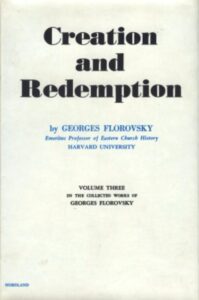
Georges Vasilievich Florovsky (1893-1979), Collected Works of Georges Florovsky, Vol. III: Creation and Redemption, Nordland Publishing Company: Belmont, Mass., 1976:
An Anglican erudite of the 17th century, Henry Dodwell (1641-1711, one-time Camden “Praelector” of History in the University of Oxford), published in London a curious book, under a rather bewildering title:
An Epistolary Discourse, proving, from the Scriptures and the First Fathers, that the Soul is a Principle naturally Mortal; but immortalized actually by the Pleasure of God, to Punishment; or to Reward, by its Union with the Divine Baptismal Spirit. Wherein is proved, that None have the Power of giving this Divine Immortalizing Spirit, since the Apostles, but only the Bishops (1706).
Dodwell’s argument was often confused and involved. The main value of the book, however, was in its immense erudition. Dodwell, probably for the first time, collected an enormous mass of information on the early Christian doctrine of Man, even if he could not use it properly himself. And he was quite right in his contention that Christianity was not concerned with a natural “Immortality,” but rather with the soul’s supernatural Communion with God, “Who only hath immortality” (1 Tim. 6:16). No wonder that Dodwell’s book provoked a violent controversy. A formal charge of heresy was brought against the author. Yet, he found some fervent supporters. And an anonymous writer, “a Presbyter of the Church of England,” published two books on the subject, presenting a careful study of the Patristic evidence that “the Holy Spirit (was) the Author of Immortality, or Immortality (was) a Peculiar Grace of the Gospel, (and) no Natural Ingredient of the soul,” and that “Immortality (was) preternatural to Human Souls, the Gift of Jesus Christ, collated by the Holy Spirit in Baptism.”…
The Man is Mortal
In current thinking nowadays, the “immortality of the soul” is usually overemphasized to such an extent that the basic “mortality of man” is almost overlooked. Only in the recent “existentialist” philosophies are we again strongly reminded that man’s existence stands intrinsically sub specie mortis. Death is a catastrophe for man. It is his “last (or rather, ultimate) enemy,” eshatos ehthros (1 Cor. 15:26). “Immortality” is obviously a negative term; it is correlative with the term “death.” And here again we find Christianity in an open and radical conflict with “Hellenism,” with Platonism first of all. W. H. V. Reade, in his recent book, The Christian Challenge to Philosophy, very aptly confronts two quotations: “And the Word was made flesh and dwelt among us” (John 1:14) and “Plotinus, the philosopher of our time, was like one ashamed of being in the flesh” (Porphyry, Life of Plotinus, I). Reade then proceeds: “When the message of Christmas Day and Porphyry’s brief summary of his master’s creed are thus brought into direct comparison, it should be plain enough that they are totally incompatible: that no Christian can possibly be a Platonist, nor any Platonist a Christian; and of this elementary fact the Platonists, to do them justice, were perfectly aware.” I would only add that, unfortunately, Christians did not seem to be aware “of this elementary fact.
Through centuries, down to our own age, Platonism has been the favorite philosophy of Christian wise men. It is not our purpose now to explain how it could and did happen. But this unfortunate misunderstanding (not to say more) has resulted in an utter confusion in modern thinking about death and immortality. We may still use the old definition of death: it is a separation of soul from body, psyhi horismos apo thomatos (Nemesius, De natura hominis, 2; he quotes Chrysippus). For a Greek it was a liberation, a “return” to the native sphere of spirits. For a Christian it was the catastrophe, a frustration of human existence. The Greek doctrine of Immortality could never solve the Christian problem. The only adequate solution has been offered by the message of Christ’s Resurrection and by the promise of the General Resurrection of the dead. If we turn again to Christian antiquity, we find this point clearly made at an early date. St. Justin was quite emphatic on the point. People “who say there is no resurrection of the dead, and that their souls, when they die, are taken to heaven are not Christian at all” (Dial. 80).
The unknown author of the treatise On Resurrection (traditionally ascribed to St. Justin) states the problem very accurately. “For what is man but a reasonable animal composed of body and soul? Is the soul by itself man? No, but the soul of man. Would the body be called man? No, but it is called the body of man. If neither of these is by itself man, but that which is made up of the two together is called man, and God has called man to life and resurrection, He has called not a part, but the whole, which is the soul and the body” (De resurr. 8). Athenagoras of Athens develops the same argument in his admirable treatise On the Resurrection of the Dead. Man was created by God for a definite purpose, for perpetual existence. Now, “God gave independent being and life neither to the nature of the soul by itself, nor to the nature of the body separately, but rather to men, composed of soul and body, so that with these same parts of which they are composed, when they are born and live, they should attain after the termination of this life their common end; soul and body compose in man one living entity.” There would no longer be a man, Athenagoras argues, if the completeness of this structure were broken, for then the identity of the individual would be broken also. The stability of the body, its continuity in its proper nature, must correspond to the immortality of the soul. “The entity which receives intellect and reason is man, and not the soul alone. Consequently man must for ever remain composed of soul and body.” Otherwise there would be no man, but only parts of man. “And this is impossible, if there is no resurrection. For if there is no resurrection, the nature of men as men would not continue” (15).
The basic presupposition of the whole argument is that the body intrinsically belongs to the fullness of human existence. And therefore man, as man, would cease to exist, if the soul had to remain for ever “disembodied.” It is precisely the opposite of what the Platonists contended. The Greeks dreamt rather of a complete and ultimate disincarnation. An embodiment was just the bondage of the soul. For Christians, on the other hand, death was not a normal end of human existence. Man’s death is abnormal, is a failure. The death of man is “the wages of sin” (Rom. 6:23). It is a loss and corruption. And since the Fall the mystery of life is displaced by the mystery of death. Mysterious as the “union” of soul and body indeed is, the immediate consciousness of man witnesses to the organic wholeness of his psycho-physical structure. Anima autem et spiritus pars hominis esse possunt, homo autem nequaquam, said St. Irenaeus (Adv. haereses V, 6.1). A body without a soul is but a corpse, and a soul without body is a ghost. Man is not a ghost without body, and corpse is not a part of man. Man is not a “bodiless demon,” simply confined in the prison of the body. That is why the “separation” of soul and body is the death of man himself, the discontinuation of his existence, of his existence as a man. Consequently death and the corruption of the body are a sort of fading away of the “image of God” in man. A dead man is not fully human.
St. John of Damascus, in one of his glorious anthems in the Burial Service, says of this: “I weep and I lament, when I contemplate death, and see our beauty, fashioned after the image of God, lying in the grave disfigured, dishonored, bereft of form.” St. John speaks not of man’s body, but of man himself. “Our beauty in the image of God” is not the body, but man. He is indeed an “image of the unfathomable glory of God,” even when “wounded by sin.” And in death it is disclosed that man, this “reasonable statue” fashioned by God, to use the phrase of St. Methodius (De resurrectione I, 34.4: to agalma to logikon), is but a corpse. “Man is but dry bones, a stench and the food of worms.” One may speak of man as being “one hypostasis in two natures,” and not only of, but precisely in two natures. And in death this one human hypostasis is broken up. And there is no man any more. And therefore man longs for “the redemption of his body” (Rom. 8:23; tin apolitrosin tu somatos imon). As St. Paul says elsewhere, “not for that we would be unclothed, but that we would be clothed, that what is mortal may be swallowed up of life” (2 Cor. 5:4). The sting of death is precisely in that it is “the wages of sin,” i.e., the consequence of a distorted relationship with God. It is not only a natural imperfection, nor is it just a metaphysical deadlock. Man’s mortality reflects man’s estrangement from God, Who is the only Giver of Life. And, in this estrangement from God, Man simply cannot “endure” as man, cannot stay fully human.
The status of mortality is essentially “subhuman.” To stress human mortality does not mean to offer a “naturalistic” interpretation of human tragedy, but, on the contrary, it means to trace the human predicament to its ultimate religious root. The strength of Patristic theology was precisely in its interest in human mortality, and accordingly in the message of the Resurrection. The misery of sinful existence was by no means underestimated, but it was interpreted not only in ethical or moralistic categories, but in theological ones. The burden of sin consisted not only in self-accusations of human conscience, not only in the consciousness of guilt, but in an utter disintegration of the whole fabric of human nature. The fallen man was no man any more, he was existentially “degraded.” And the sign of this “degradation” was Man’s mortality, Man’s death. In separation from God human nature becomes unsettled, goes out of tune, as it were. The very structure of man becomes unstable. The “union” of the soul and the body becomes insecure. The soul loses its vital power, is no more able to quicken the body. The body is turned into the tomb and prison of the soul. And physical death becomes inevitable. The body and the soul are no longer, as it were, secured or adjusted to each other.
The transgression of the Divine commandment “reinstated man in the state of nature,” as St. Athanasius puts it, — is to kata fysin epestrepsen. “That as he was made out of nothing, so also in his very existence he suffered in due time corruption, according to all justice.” For, being made out of nothing, the creature also exists over an abyss of nothingness, ever ready to fall into it (De incarnatione, 4 and 5). “For we must needs die, and are as water spilt on the ground, which cannot be gathered up again” (2 Samuel 14:14). “The state of nature,” of which St. Athanasius speaks, is the cyclical motion of Cosmos, in which fallen man is hopelessly entangled, and this entanglement signifies man’s degradation. He loses his privileged position in the order of Creation. But this metaphysical catastrophe is just a manifestation of the broken relationship with God.
– Chapter VI, “Dimensions of Redemption”, pp. 213-240. (Original article: “The Resurrection of Life”, in Bulletin of the Harvard University Divinity School, XLIX, No. 8 (April 1952), pp. 5-26.).
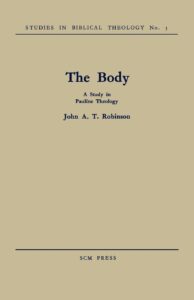
John A. T. Robinson, The Body – A Study in Pauline Theology, SCM Press, England, 1952 (This cover is from 2012 Edition (Hymns Ancient & Modern Limited, England):
It follows from this that the third and perhaps most far-reaching of all the Greek antitheses, that between body and soul, is also foreign to the Hebrew. The Hellenic conception of man has been described as that of an angel in a slot machine, a soul (the invisible, spiritual, essential ego) incarcerated in a frame of matter, from which it trusts eventually to be liberated. The body is non-essential to the personality: it is something which a man possesses, or, rather is possessed by. ‘The Hebrew idea of personality,’ on the other hand, wrote the late Dr. Wheeler Robinson in a sentence which has become famous, ‘is an animated body, and not an incarnated soul’ (The People and the Book, 362). Man does not have a body, he is a body. He is flesh-animated-by-soul, the whole conceived as a psycho-physical unity: ‘The body is the soul in its outward form’ (J. Pedersen, Israel, I-II, 171). There is no suggestion that the soul is the essential personality, or that the soul (nephesh) is immortal, while the flesh (basar) is mortal. The soul does not survive a man it simply goes out, draining away with the blood.
– p. 14.

Nils Fredrik Bolander, “Ingen död kan döda oss” [“No Death Can Kill Us”], Tidningen, Stockholm, Sweden, 1952:
At times one encounters a vague piety which speaks of death as a redemption and a release. In the deliverance through death, they say, man goes home to God. But this is not true. In any case, the Bible does not teach it. It states clearly and definitely that it is not death but the day of Jesus Christ which comes with the resurrection from the dead and redemption.
… We must attain to a personal faith in Christ. Jesus says: ‘I am the resurrection and the life: He that believeth in me, though he were dead, yet shall he live.’… Where this simple, artless, and blessed faith flames up in a lonely human heart, a new light falls upon one’s being.
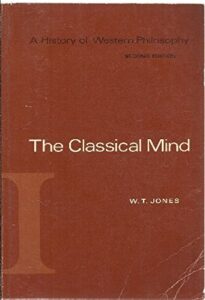
William Thomas Jones, A History of Western Philosophy –The Classical Mind, Harcourt, Brace & World, USA, 1952 (This cover is from Second Edition, 1969).
There are some obvious similarities between Plato’s god and the Christian God. Like the Christian God, Plato’s god is good; he is a creator; what he creates is a universe oriented and ordered in terms of human destiny. Because of these similarities and for other reasons as well, Platonism, as we shall later see, had a marked influence on Christianity. Much of the thought of the early Middle Ages was Platonic in the sense that many of the Church fathers formulated their specific Christian insights into a philosophy whose basic concepts were borrowed from Plato.
– p. 168.
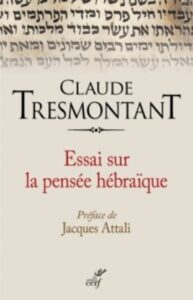
Claude Tresmontant, Essai sur la pensée hébraïque, éd. O.E.I.L., Paris, France, 1953. (In English : A Study in Hebrew Thought, New York: Desclee, 1960):
… we must be careful to avoid interpreting the Hebrew notion of soul in terms of Platonic dualism. Because they recognized no body-soul dichotomy, the Hebrews did not consider the soul the discarnate thing that we imagine it to be. And it is just because we oppose it to ‘body’ that we think of it in this way. In Hebrew the soul is the man. Indeed we should not say that man has a soul, but that he is a soul; nor consequently that he has a body, but that he is a body.
– p. 94 (English edition).
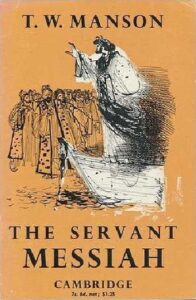
Thomas Walter Manson, The Servant Messiah – A Study of the Public Ministry of Jesus, Cambridge University Press, Cambridge, England, 1953 (This cover is from 1961 edition).
There are many uncertainties to be reckoned with in tracing the history of Jesus and the early Church, but here is one certainty: the Ministry of Jesus was not stopped. The Roman and Jewish authorities had hardly begun to congratulate themselves on having dealt with another crisis in a statesman-like way, when the crisis was upon them again in a new form. The disciples, cowed and dispirited, had hardly begun to ask themselves what they should do next or where they could safely go, when the answer was given to them in the way they least expected. The Crucified was alive again and active among them. From the first Easter Sunday onwards the recurrent refrain in the talk of the disciples, whether among themselves or in their contact with others, is, ‘He is risen’, ‘God has raised him from the dead.’. It is the resurrection of Jesus that is asserted and believed, not the immortality of souls, including the soul of Jesus.
It is therefore important that we should be clear about what the word ‘Resurrection’ meant in New Testament times. It had nothing whatever to do with the survival of disembodied spirits in some heavenly sphere. On the contrary, it was essentially a restoration to life in this world, a bringing back of the dead person from the cold and shadowy underworld to resume his place among his kinsfolk and friends and to recover the health and vigour that were his before he died. Even if the conditions of existence are supposed to have been drastically changed before the resurrection takes place, it is recognizably the same person who returns to rejoin people, who will recognize him. And however much the conditions may have changed, it is assumed that there will be a real continuity of purpose and activity between the new life and the old, just as there is a real continuity of personality between the man who died and the man who returns to life. The nearest thing in our ordinary experience to the Jewish and early Christian idea of death and resurrection is falling asleep and waking up; and it is very significant fact the the first unmistakable reference to the resurrection of the dead in the Old Testament is made in terms of sleeping and waking: ‘And many of them that sleep in the dust of the earth shall awake, some to everlasting life, and some to shame and everlasting contempt.’ And equally, when there is no expectation of a resurrection the natural way to express it is in terms of a sleep from which there is no awaking:
Man lieth down and resth not: Till the heavens be no more, they shall not awake, Nor be roused out of their sleep. (Job xiv.12)
Now, one of the standing wonders of life is just the fact that when I come out of oblivion any fine morning, I am at once aware that I am the same person that lived in my house yesterday and went to sleep there last night. The task I left unfinished yesterday is still there, still my task, and I can take it up where I left off. The plans I was making yesterday are still there waiting for further consideration and elaboration. This continuity of personality and life is a great marvel: and it is only excessive familiarity with it that hides its wonder from us. When we try to think of death and resurrection as the first Christians thought of them, we cannot do better than to think in terms of sleeping and waking and the wonderful way in which the self contrives every night to leap the dark gulf of unconsciousness and arrive safely on the other side complete with all its hopes and fears, joys and sorrows, memories of the past and plans for the future.
It is a corollary to this that when people seek for evidences of the immortality of the soul they tend to find satisfaction either in philosophical arguments, of which the Phaedo is a magnificent example, or in alleged communications from the spirit world. Evidences of resurrection must needs be more closely connected with this world; and that is the case with the evidences for the resurrection of Jesus.
– pp. 89-91.
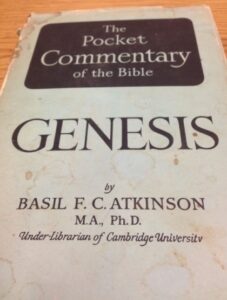
Basil Ferris Campbell Atkinson, The Pocket Commentary of the Bible, Part 1, Book of Genesis, publ. by Henry E. Walter, England, 1954:
It has sometimes been thought that the impartation of the life principle, as it is brought before us in this verse, entailed immortality of the spirit or soul. It has been said that to be made in the image of God involves immortality. The Bible never says so. If it involves immortality, why does it not also involve omniscience, or omnipresence, or any other quality or attribute of the Infinite? Why should one alone be singled out? The breath of life was not breathed into man’s heart, but into his nostrils. It involved physical life. Throughout the Bible man, apart from Christ, is conceived of as made of dust and ashes, a physical creature, to whom is lent by god a principle of life. The Greek thinkers tended to think of man as an immortal soul imprisoned in a body. This emphasis is the opposite to that of the Bible, but has found a wide place in Christian thought.
– p. 32.
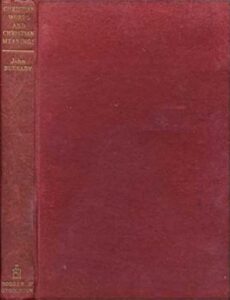
John Burnaby, Christian Words and Christian Meanings, Hodder and Stoughton, London, UK, 1955:
Greek philosophers had argued that the dissolution which we call death happens to nothing but bodies, and that the souls of men are by their native constitution immortal. The Greek word for immortality occurs only once in the New Testament, and there it belongs to none but the King of Kings… The immortality of the soul is no part of the Christian creed, just as it is no part of Christian anthropology to divide soul and body and confine the real man, the essence of personality, to supposedly separable soul for which embodiment is imprisonment… Jesus taught no doctrine of everlasting life for disembodied souls, such as no Jew loyal to the faith of his fathers could have accepted or even understood. But Jewish belief was in the raising of the dead at the Last Day.
– pp. 148, 149.
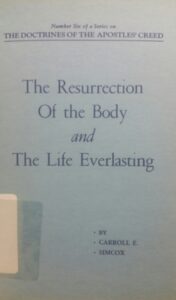
Carroll Eugene Simcox, The Resurrection of the Body and the Life Everlasting (The Doctrines of the Apostles’ Creed Series, Number 6), Forward Movement Publications, USA, 1955.
Our first logical step is to make a distinction between two very different things: immortality and resurrection.
… Most non-Christians have always believed in some kind of immortality of man and hence in some life beyond the grave. Many have envisioned a life to come that is indeed beautiful and glorious. But they have based their hope for this life to come entirely on the theory of the immortality of man. The essence of this theory is that there is some imperishable something in man himself which death cannot destroy: so long as this something cannot die, man himself cannot die. This theory of the imperishable-something in man has commended itself to the reason of most of the wisest men. Yet it can never be anything more than a theory. If the theory is false, man’s hope for life beyond death is grounded in a bad guess.
… the Christian has an entirely different reason for believing in the life to come. He believes in resurrection, and he believes that he has sufficient reason to consider resurrection not so much a theory as an established fact.
… [According to this theory of immortality] while man is in this present life, his soul and his body are in a temporary working partnership. Soul is by its very nature immortal: it cannot die. It is the imperishable-something. Body is mortal and must die. What happens, then, at death? The partnership of soul and body is dissolved. The body disintegrates into dust, and for all practical purposes ceases to be.
… Nevertheless, it is all a guess about the Grand Perhaps, whether we think it a reasonable guess or not. It can never be established as a certainty. We must understand that it may be nothing more than what the psychologists call a wish-projection: a fantasy of pure wishful thinking.
… This doctrine of immortality is not distinctly Christian. Most Christians have believed it, but not on Biblical and Christian grounds. The Bible does not teach it. The Bible knows no such sharp distinction and radical cleavage between soul and body. This doctrine in its familiar form comes down to us, not from the people of Israel and the early Christians, but from the philosophers of Greece: the most brilliant guessers in all history, but still guessers.
… One important difference between it [resurrection] and the immortality doctrine is this: the resurrection doctrine thinks of the whole man as a whole. It does not divide man into two or more parts. It allows us to call something in man ‘soul,’ something else in man ‘mind,’ something else ‘body’; but the Bible never theorizes about that. If man lives, the whole man lives; if man dies, the whole man dies; if man suffers, the whole man suffers-soul, mind, body, all of him. Whatever elements together make up a human life, their togetherness – rather than their differentness – is the important fact about them. Man is a single being, in life and in death.
… If we base our hope for life after death on the theory of immortality, we are putting our faith in man, in this immortal something in man. If we base our hope on the Christian ground of resurrection, we are placing our faith in God rather than in man, in the divine power and goodness rather than in human nature. Surely this makes a tremendous difference, if we believe in God at all. The theory of immortality says that we shall live beyond the grave because we are incapable of dying. The Christian claim of resurrection (it is a claim, not a theory, as we shall see later) asserts that we shall live beyond the grave because God, in His mighty love and loving might, raises us from death to life. In whom do we put our trust: in God, or in ourselves?
… I affirm that the whole person – as we might say today ‘the complete personality’ – is raised by God’s power from death to life eternal.
– excerpts from pp. 3-8.
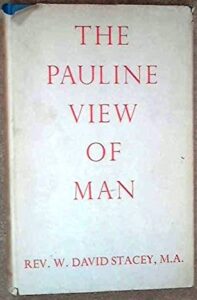
The Pauline View of Man in Relation to its Judaic and Hellenistic Background, David Stacey, MacMillan & Co, London, England, 1956:
… nephesh met in Nu. 6.6 does not refer to a dead body, but implies that the soul was still present though death had taken place. He quotes Job 14:22, ‘But his flesh upon him shall have pain, and his soul within him shall mourn,’ to prove that corruption afflicted both body and soul together.
Dr. Oesterley argues that the nephesh could ‘slip in and out of the body at will.’ He points out that the departure of Rachel soul meant death (Gen. 35:18) and the return of the child’s soul (1 Kin. 17:22) meant life. This cannot be gainsaid, but we must beware of inferring from these references a dualistic notion of body and soul which is at variance with the fundamental inclusiveness which is the key to Hebrew psychology. These references show that the nephesh can leave the body and return, but beside them must be set references such as Prov. 25.25 and 27.7, where water and honey delight the soul, showing that body and soul are inextricably bound up. The only solution is that the Old Testament is not entirely consistent in its understanding of nephesh. It is nourished through the body, yet can depart from it. It does not, however, follow that nephesh could conduct an independent existence outside the body. The departure of nephesh coincided with the cessation of life, which only means that nephesh was the vital force. Incorporeal life for the nephesh was never visualized. Death afflicted soul (Nu. 23.10) as well as body, and if the nephesh appears again in Sheol, it is only for an inferior existence, and even this existence is not immaterial.
– p. 88 (Hebrew words transliterated).
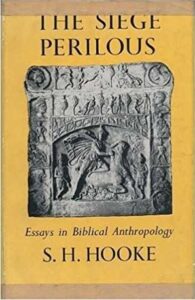
Samuel Henry Hooke, The Siege Perilous: Essays in Biblical Anthropology and Kindred Subjects, S.C.M. Press, London, England, 1956:
What has Christianity Inherited from Judaism?…
The form in which the Church received and has continued to hold the belief in resurrection was, and has remained, Jewish. The late Professor H. Wheeler Robinson has well remarked in this connexion:
‘It is a life on earth, however new its conditions, and it is a resurrection-life, involving the restoration of the dead body. This form of belief is seen to have been inevitable, once we have grasped the Hebrew idea of personality; a resurrection of the body was the only form of triumph over death which Hebrew psychology could conceive for those actually dead. Even St. Paul shrinks from the thought of bodiless existence.’ (Inspiration and Revelation in the Old Testament, p. 101-2.).
The Greek doctrine of immortality, which finds its first Jewish expression in the Wisdom of Solomon, and which conceives of an immortality of the soul apart from the body, does not occur in the New Testament, nor in the Creeds. Even the Alexandrian Fathers appear to assume the identity of the ‘spiritual body’ spoken of by St. Paul with the earthly body, without, however, explaining the nature of the identity. The permanent value of this element of the Jewish heritage is, to say the least, open to question, and the Fourth Gospel seems to represent an attempt to reinterpret early Christian eschatology, and especially the Parousia expectation, in such a way as to remove some of its less desirable aspects.
– pp. 201, 202.
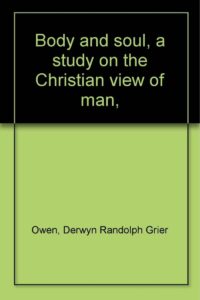
Derwyn Randulp Grier Owen, Body and Soul: A Study on the Christian View of Man, Westminster Press, Philadelphia, USA: 1956 (this is not the actual book cover):
If we turn to the Bible, however, as we shall later, we find that a quite different view of man is assumed throughout. Here there is no dualism and scarcely any idea of the immortality of a detached and independent soul…
Plato remains to the end an antiphysical dualist. It is he, and his followers, who most of all are responsible for imposing the “religious” anthropology on Western thought…
This latter belief especially – the idea that the soul can exist apart from the body – obviously implies some form of body–soul dualism… This body-soul dualism was a necessary implicate of the Greek doctrine of the immortality of the soul…
Now there are a few isolated Scriptural passages that may suggest the idea of the immortality of the soul in the Greek sense, but the normal Biblical point of view is quite different: in the New Testament it is the resurrection of the body that is stressed, and this doctrine is almost a direct contradiction of the “Orphic” eschatology. Why, then, did the Fathers lean toward this largely un-Biblical notion?…
The fact is that the Fathers’ adoption of the “religious” idea of the immortality of the detachable soul forced them into the doctrine of body-soul dualism…
The idea of the intermediate state eventually developed into the doctrine of purgatory…
The Fathers were no doubt impressed by the force of the arguments advanced by Greek philosophy to prove the immortality of the soul. And, finally, of course, the idea of an intermediate state gave the human being another chance to be purged of his sins before the last judgment. It was the development of this notion that led to the doctrine of purgatory, with all the superstitions and objectionable practices that eventually made up the purgatorial system and, in the end, furnished part of the immediate cause of the Reformation…
Their (Church Fathers) resulting anthropology was a mixture of Biblical and Greek ideas. They added to the New Testament doctrine of the resurrection of the body the idea of an intermediate state in which the soul exists apart from the body, awaiting its recovery at the end…
The “religious” anthropology, as far as Western thought is concerned, is Greek and not Biblical in origin. It is also typical of Eastern religions in general, such as Hinduism and Buddhism. It seems to be characteristically “religious,” and for this and other reasons has tended to creep into and corrupt the Christian view of man. This happened, as we saw, in the patristic and medieval periods, and modern Catholicism and Protestantism have tended to perpetuate this early mistake…
The Biblical view of man is entirely different from the `religious’…
The points at issue revolve around the concepts of “body” and “soul.” The “religious” anthropology (in contradistinction to the Biblical) adopts an extreme dualism, asserting that the body and the soul are two different and distinct substances. It claims that the soul is divine in origin and immortal by nature and that the corruptible body is the source of all sin and wickedness. It recommends the cultivation of the soul in detachment from the body, and advocates the suppression of all physical appetites and natural impulses. It regards the body as the tomb or prison of the soul from which it longs to get free. Finally, it tends to suppose that the soul, even in its earth-bound existence, is entirely independent of the body and so enjoys a freedom of choice and action untrammeled by the laws that reign in the physical realm…
The Hebrews had no idea of the immortality of the soul in the Greek sense… It was impossible for them even to conceive of disembodied human existence…
The idea of the immortality of the soul in the Greek sense may be suggested in some passages in the wisdom literature and is definitely found in places in the Apocrypha. This line of thought was later developed in the Hellenistic Judaism of the Alexandrine School, in the inter-testamental period, of which the religious philosopher Philo is the outstanding example.
– pp. 29, 41, 59, 61, 62, 77, 163, 164, 177 and 178.
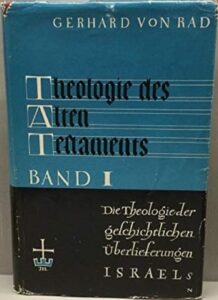
Gerhard von Rad, Theologie des Alten Testaments [Old Testament Theology] (Bd. 1: Die Theologie der geschichtlichen Überlieferungen Israels; Bd. 2: Die Theologie der prophetischen Überlieferungen Israels.) [Vol. 1: The Theology of the Historical Traditions of Israel; Vol. 2: The Theology of the Prophetic Traditions of Israel.], 1957 (This cover is from 1958 edition – Vol. 1):
There is absolutely no unity in the ideas of the Old Testament about the nature of man. And, of course, uniformity is not to be expected there, because in the source material the body of ideas with which we meet derive from the most diverse periods and circles, and Israel felt even less need to unify these anthropological concepts or to reduce them to a norm than she did with her theological traditions. The most important concept in this anthropology is that of the נֶ֫פֶשׁ [nephesh]. It is what is l alive – once or twice in the Old Testament the word retains its basic meaning of “throat, gullet” (Is. v. 14, etc.), and it signifies that which is vital in man in the broadest sense – the נֶ֫פֶשׁ [nephesh] feels hunger (Deut. XII. 15), it loathes (Num. XXI. 5; Ezek. XXIII. 18), it hates (II Sam. v. 8), feels anger (Jg XVIII. 25), loves (Gen. XLIV. 30), weeps (Jer. XllI. 17), and, most important of all, can die (Num. XXIII. 10; Jg. XVI. 30) – that is “departs” (Gen. XXXV. 18) – and it sometimes “comes back into a person again” (I Kings XVII. 21ff.). Since the Hebrews did not distinguish between the intellectual and the vital functions of the body בָּשָׂר (basar), we should refrain from translating this term as “soul” wherever possible. The נֶ֫פֶשׁ [nephesh] dwells in the “flesh” (Deut. XII. 23), though it is clearly distinguished from it (Is. X. 18). Animals too have a נֶ֫פֶשׁ [nephesh], but plants do not. In the relatively few instances in which it occurs, and where it is used with anthropological reference and not as the designation of a charisma, man’s intellectual element is better described by the term רִיחַַ [rûah]. The seat of all the activities of the human mind is the “heart” לֵב [leb]. But the expositor must always bear in mind that this term is much more comprehensive than our “heart.” לֵב [leb] is not only-the seat of the whole of the emotions, but also of the reason and the will. The most secret stirrings of the souls were thought of as resident within the kidneys (כְּלָי֖וֹת [kelayot]) – see Ps. LXXIII. 21; Jer. XVII. 10, etc.
– Gerhard von Rad, Old Testament Theology, 1962, Harper & Row, Publishers, New York, Hagerstown, San Francisco and London, Vol. 1, pp. 152, 153 (transliterations added and footnotes ommited).
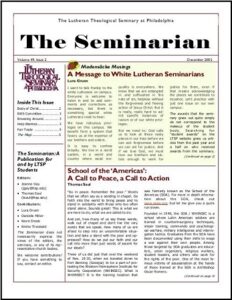
Gilbert Thiele, The Resurrection of the Body and the Immortality of the Soul, unpublished paper,1957.
What a tragedy that this perversion, understandable and explicable from the Socratic view and the Platonic presupposition, but unpardonable as either the first or the last word for Christians, has become part of the sum and substance of much theology known to us! When we so speak: You have an immortal soul which Christ died to save; and when you die your soul(s) goes to God and to heaven. Is that not comforting? – when we so speak, we are essentially speaking the language of Plato, of Lessing, of the English and Continental Enlightenment thinkers, of Freemasonry, of the worst of all early-Church opposition, Gnosticism, and of Docetism…
Death, furthermore, is final. This is the most gloomy of all aspects of death — it is the end. When you die, “You’ve had it.” There is “no remembrance” – of God, of yourself, the few passages that seem to indicate a measure of hope notwithstanding. We think it is consequently fair to say, to put it very bluntly, that when a man dies, he is dead. The Bible when examined in its length and breadth knows of no disembodied condition in which man lives, temporarily, and certainly not permanently; it knows of neither a temporary nor permanent immortality as such. Man, as the Genesis account seems to indicate, may have been created originally to live forever, as he was or even more ennobled than he was; but certainly since his defection he is a Todes-Kandidat (goner). Neither bodily nor psychic dichotomy and consequently neither a separate bodily nor psychic immortality are taught in the Scriptures.
– pp. 5, 6. Later, it was published in the article entitled “Easter Hope”, The Seminarian (Lutheran Theological Seminary at Philadelphia, USA), March, 1958.
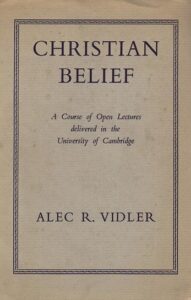
Alec Roper Vidler, Christian Belief: An Exposition of the Basic Christian Doctrines, SCM Press, United Kingdom, 1957:
The immortality of the soul – if it means that there is a part of every man, a kind of soul-substance, that is immortal – is not a Christian doctrine, though it has often been supposed to be and is still frequently confused with the Christian doctrine. The expression ‘immortality of the soul’ does not occur in the Bible. The Bible is preoccupied with God and his relation to mankind. It does not speak about any inherent capacity of the human soul to survive death…
It is not of the immortality of the soul but of the resurrection of the body that Christian belief, like the Bible, speaks. In God’s new, immortal creation men are not ghosts; they are not disembodied spirits; they are not absorbed into an unconscious cosmic soul. They retain their personal identity, for God’s purpose for them is an inheritance in which nothing will be lacking to a fully personal relationship. The work of Christ is to bring not only souls but whole men into a complete and eternal relationship with God…
There is another point about the doctrine of the resurrection of the body, as distinguished from that of the immortality of the soul, which should not be overlooked. The word ‘immortal’ means not subject to death, and applied to man it must mean that there is at any rate part of a man which need not and in fact cannot die. The word ‘resurrection’ on the other hand presupposes the death of the whole man, every part of him. And this is in line with the whole tenour of the New Testament, for there the fact of universal death is taken seriously. ‘In Adam all die.’ It does not use euphemisms such as ‘passing on’ or ‘passing over’ which are popular nowadays. Death with all that it entails of separation, tragedy and mystery is a bitter necessity. The death of a man is not only natural like the death of animals or vegetables; it is also unnatural. We rebel against it.
– excerpts from pp. 110-113.
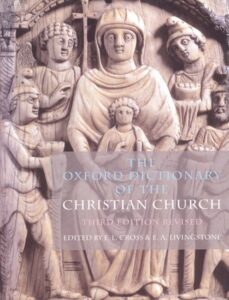
The Oxford Dictionary of the Christian Church, Oxford University Press, New York, USA, 1957 (This cover is from 3rd Edition Revised, 2005):
immortality. Though in no sense a specifically Christian doctrine, the hope of immortality is an integral element in Christian belief, where it receives emphatic insistence and a characteristic shape. In pre-Christian times, the Greeks esp. developed a reasonned doctrine on the subject. The rationality of the human intellect seemed to imply an essntial kinship of the soul with the principles of reason, so that it partook of their eternity. From this kinship Plato inferred the existence of the soul before birth as well as its survival of death and saw in the process of learning the reminiscence (αναμνήσις) of knowledge possessed in a previous life. The striving of the virtuous man after the eternally valid principles of morality also pointed to the same belief. Plato and other Greeks insisted on the limitations which matter imposed on the soul. The body was an impediment, even a prison-house, from which death brought to the soul release into a fuller existence.
Such philosophical conceptions of immortality have commonly been confined to the few. In early times Hebrew thought about the next world hardly exceeded the conception of a very shadowy [unreal, insubstantial, intangible] existence in Sheol. In later pre-Christian Judaism a greater sense of the reality of the future life developed, partly through reflection on the problem of suffering, partly from the ardent desire for abiding communion with God, partly through the recasting of the Messianic expectation. The Jewish hope became increasingly bound up with belief in the resurrection of the body, esp. in the Apocalyptic writers. Esp. outside Palestine, Judaism borrowed extensively from Greek thought; in the Book of Wisdom, e.g., the doctrine of immortality has a strong Platonic bent…
soul. The idea of a distinction between the soul, the immaterial principle of life and intelligence, and the body is of great antiquity, though only gradually expressed with any precision. Hebrew thought made little of this distinction, and there is practically no specific teaching on the subject in the Bible beyond an underlying assumption of some form of afterlife (see IMMORTALITY). Greek thought, on the other hand, developed various ways of understanding the relation of body and soul: from the Platonic idea that the immortal soul is the true self, imprisoned for a time in an alien body, to the Stoic view of the soul as the ‘leading element’ (ἡγεμονικόν [hégemonikon]) of a unity which includes the body. No precise teaching about the soul received general acceptance until the Middle Ages.
This uncertainty is reflected in the writings of the Fathers. Tertulian, supporting his view by the material imagery of the parable of Dives and Lazarus and influenced by Stoic notions, held the corporeity of the soul, an error from which even St Ireaneus does not seem to have been entirely free. Origen, on the other hand, was led by his strongly Platonist learnings to affirm its pre-existence and explained its confinement in a body as a punishment for sins commited in its previous incorporeal state. In the post-Nicene period these divergences largely disappeared, and a modified Platonic view, seeing the soul as the true self, immortal but not pre-existent, won acceptance. The soul came to be universally regarded as an image of God (cf. Gen. I:26). St Augustine gave this doctrine a novel turn by seeing the soul (consisting of memoria, intelligentia, and voluntas) as an image of the Trinity; this formulation was destined to have great influence in the W. Nemesius and St Maximus the Confessor provide the most elaborate statement of the Greek patristic position.
Acc. to St Thomas Aquinas, who follows Aristotle in his definition of the human soul, the soul is an individual spiritual substance, the ‘form’ of the body. Both, body and soul together, constitute the human unity, though the soul may be severed from the body and lead a separate existence, as happens after death. The separation, however, is not final, as the soul, in this differing form the angels, was made for the body. As it is purely spiritual, the soul is not, as Traducianism affirms, a product fo the generative, and therefore entirely material, powers of man, but each individual soul is a new creation of God, infused into the body destined for it (‘Creationism’).
From the 17th cent. R. Descartes oversimplified dichotomy between soul and body (res cogitans and res extensa) has had a marked effect on subsequent theological thought. In more recent times, philosophical perplexities over such a dichotomy and the recovery of the biblical insight into the unity of man have meant that the doctine of the soul, if considered at all, is thought of in relation to the whole biblical doctrine of man.
– 3rd Edition, Edited by F. L. Cross and E. A. Livingstone, 1997, pp. 822, 1520, 1521.
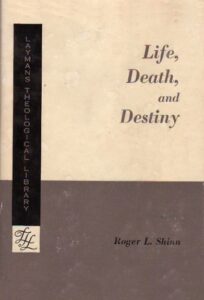
Roger Lincoln Shinn, Life, Death and Destiny, The Westminster Press, Philadelphia, USA, 1957:
Children ask difficult questions about cemeteries. Maybe we all do, but children do it out loud. Grandmother has been sick, then has died. Someone tells the child that Grandmother has gone to God. But someday the child asks about the graveyard. Is Grandmother in the cemetery or with God?
One answer is: Grandmother’s body is in the grave, but her soul is with God. With luck that answer stops questions.
Someday, then, the child hears the Apostles’ Creed: “I believe in … the resurrection of the body.” His question usually brings the answer: “That really means the soul.” Now and then someone insists that in really does mean the body. Maybe he opposes cremation, because he wants his body ready for God to raise in the Last Days – though why God should have more trouble with ashes than with decomposed flesh is not clear.
Pretty soon a nonsensical argument is under way. Notice how the New Testament dismisses these futile guesses:
1 – The bickering Sadducees ask Jesus about the widow who remarries. (Just to be smart alecks, they give her seven successive husbands.) Who will be her husband in heaven? Jesus, who never avoids a sincere question, gives this one the brush-off. You can’t answer questions about heaven in earthly terms, he tells them. You don’t understand the power of God. (See Mark. 12:18-27).
2 – Someone presses Paul with a question about the bodies of those raised from the dead. The apostle, who always likes a good question, explodes, “You foolish man!” (I Cor. 15:36).
Some questions are just futile. Whenever we use words out of common experience to describe the works of an infinite God, the words don’t quite fit. Literal answers to questions about life after death are mostly foolishness.
Once we realize this, we can go a step farther. An artist spreads pigments on a flat canvas to suggest not only dimensions of depth but hidden experiences of the human spirit. A musician uses vibrating strings from animal intestines to convey joy, humor, or grief. Words similarly have symbolic power. They may tell us more when we realize their inadequacies than we think they give us literal truth.
When the early Christians said “resurrection of the body”, they were not kidding themselves. They were not slow-witted people who had not thought of the question the child asks about the cemetery. They said clearly that “flesh and blood cannot inherit the kingdom of God.” Decay of corpses was no problem for them. Yet they found reason to hang onto this idea of a body – a “spiritual body”, they called it. (You can find all this discussed in I Cor., ch. 15.).
The New Testament could have used different language. All the educated people had heard the theory that at death the soul soars to heaven while the body goes to the grave. But that language did not click with the Jewish Christians who wrote the New Testament.
The Jews just never had believed that a person is a soul plus a body – a detachable combination temporarily hooked up. Today practically every psychologist agrees with the Jews on this issue. When we talk wisely of psychosomatic medicine or trace a person’s disposition to the activity of his glands, we are doing (with more or less scientific precision) what the Biblical writers did intuitively. In Christian history, Augustine did the same thing when he said, in words that all our modern knowledge vindicates, “For the body is not an extraneous ornament or aid, but a part of man’s very nature.”
Some very “spiritually minded” people argued against this Christian belief. They quoted Plato’s, Phaedo: “Whence come wars, and fightings, and factions? Whence but from the body and the lusts of the body?… And what is purification but the separation of the soul from the body?” For Christians this was an utter evasion. It meant unhealthy abhorrence of the body and blindness to the sins of the spirit.
So the Church hung onto its concern for a complete person, not for a soul plus a detachable body. It preached God’s salvation of real people, not of mystic souls that might get absorbed in some divine soul. It taught God’s concern for history, realizing that most history is connected with human bodies. So, at the risk of being misunderstood, it kept talking of a resurrection of the body – meaning not the chemical components of the body but the wholeness of the human being.
None of this tells us literally and exactly what is going to happen. Of course not. “O foolish man!” We cannot know. Christian Faith, we have seen, talks of a new creation as miraculous as the first creation. The only basis for belief in it is trust in God. If that does not convince us, neither will any enticing preview of coming attractions.
– pp. 81-84.
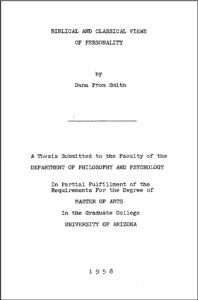
Dana Prom Smith, Biblical and Classical Views of Personality. (thesis of Master of Arts) – http://hdl.handle.net/10150/319602. University of Arizona, USA, 1958:
What happens to the israelite when he dies? What is his ultimate destiny? Death is seen as a weak form of life. Man becomes a mere shadow of his former self. There is a relative weakness on the part of the dead as compared with the vitality of the state of the living. This is precisely why the Israelite yearned for a long life. It was a sign of the Lord’s favor. “In short, the normal Israelite view, which dominates the conception of man in the Old Testament, is that to be in sickness of body or weakness of circumstance is to experience the disintegrating power of death, and to be brought by Yahweh to the gates of Sheol; but to enjoy good health and material prosperity is to be allowed to walk with Him in fullness of life.” Therefore it is not quite proper to say that the Israelite had no conception of life after death. He had one. Life after death was weakness and lack of vitality. This is a far cry from the idea of the indestructibillty of an immortal soul which leaves the body at death to enjoy perpetual bliss.
This brings us to the New Testament and the view of man that prevails there. It is quite proper to begin with St. Paul, for here we find a certain body of beliefs attributable to one man. The rest of the New Testament, especially the Gospels, will be related to Paul’s thought…
It is easy to see how confusion has arisen about Paul’s thinking about body and soul. People see the word sarx used in this latter sense [the physical], and they identify it with the physical body. Paul, being a good Hebrew, could never say that anything God had made was intrinsically evil. In this usage of the word sarx we still see the same unity of the personality. The personality has set itself over against God. The conflict in man between spirit and sarx is a moral conflict and not a metaphysical clash…
Paul’s doctrine of the resurrection bears directly upon our problem. We saw how the Old Testament did not have very much to say about the ultimate destiny of man. Paul does not state in his doctrine of the resurrection that the soul and the body separate. He states that the physical body is changed into a spiritual body, the mortal body is changed into a body immortal (1 Cor. 15:42-49).
In other words, man as a whole does not divide into two or three parts at death with some continuing and others ceasing to exist. Man as a whole personality continues his existence. Man is not a metaphysical dualism but a unity and this unity is not broken by death. The unity is changed from physical to spiritual, and Paul admits, that this is a mystery. The important point for our consideration is that man does not possess an indestructible soul that survived death, while the destructible body perishes. It is the sarx or the alienation that dies, not the soma or personality. There is not an immortality of the soul but the resurrection of the body.
– pp. 12-17.
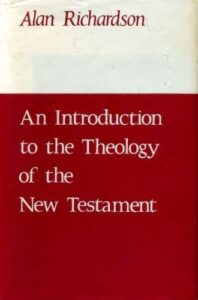
Alan Richardson, An Introduction to the Theology of the New Testament, SCM Press, London, England, 1958 (this cover is from 1969 edition).
The fact that the tomb was found to be empty on Easter Sunday morning appears to be a part of the original παράδοσις of the resurrection, and not just a later addition designed for apologetic purposes (as perhaps Matthew’s story of the Guard may be; Matt. 27.62-66; 28.11-15). The oldest MSS. of St Mark end with the finding of the tomb empty by the women who had gone ‘very early on the first day of the week’ to anoint the body of the crucified Master (Mark 16.1-8; cf. Matt. 28.1-7; Luke 24.1-12; John 20.1-10). The notion that the resurrection of Christ was a purely ‘spiritual’ affair, while his corpse remained in the tomb, is a very modern one, which rests upon theories of the impossibility of miracle drawn from nineteenth-century physics. Supporters of this view have claimed that there is no reference to the Empty Tomb in the παράδοσις which St Paul received (I Cor. 15.3-8) and that it could not therefore have been a part of the primitive tradition. Against this argument it may be replied that St. Paul and others may have omitted the story of the visit of the women to the tomb because they did not wish it to be thought that the case for the resurrection of Christ was dependent upon the evidence of hysterical women. But more important is the consideration that to St Paul, as to any other Jew of the time, a merely ‘spiritual’ resurrection would have appeared unintelligible. Unlike the Greeks, the Jews did not think of a man as being made up of a body and a soul; a man was a living body. If Christ was raised from the dead, he must have been raised in the body. Thus, Paul cannot conceive of those who are risen in Christ as existing in a disembodied state: they have a ‘spiritual body’ (I Cor. 15.44). Spiritual realities, celestial or terrestrial, divine or human, are embodied in their own appropriate embodiments (I Cor. 15.35-41). When the earthly house of our tabernacle is dissolved, we shall be clothed upon with our habitation from heaven, so that we shall not be found naked (II Cor. 5.1-3), i.e. with the kind of nakedness which disembodied spirits endure. The notion of a disembodied person is repugnant to the Hebrew mind; a πνεῦμα is something unnatural, monstrous and evil, and the idea that the Risen Christ is such a πνεῦμα is rejected with horror (Luke 24.37). It is exceedingly unlikely that St Paul would have countenanced any notion of Christ’s resurrection other than that of a physical resurrection in the sense of the narratives of the Empty Tomb.
– pp. 196, 197.
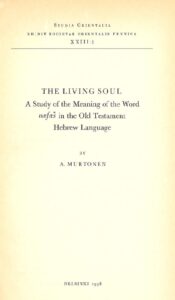
A Murtonen, The Living Soul: A Study of the Meaning of the Word Næfæš in the Old Testament Hebrew Language, Studia Orientalia Edidit Societas Orientalis Fennica XXIII:1, Helsinki, Finland, 1958:
We have established already that it is quite natural that the soul dies. In the OT the word næfæš appears expressly in this connection 46 times. In the versions – older as well new ones – it is usually rendered in these cases by the words “dead”, “body”, a pronoun, or something like that. In the following we give some characteristic examples:
Lv xxii 4 states that any priest who touches anything that is unclean through the contact with a soul will be unclean until the evening. AV and ARV translate næfæš here “dead”. But how can næfæš, the usual meaning of which it “the living being of man”, have acquired the meaning “dead”? It should be observed, that the Bible nowhere speaks of a dead soul. The death of a soul and the soul of a dead are spoken of, but never a dead soul. With other words, the soul is, according to the ancient Israelitic conception, able to die, but the result is not a dead soul, but the soul of a dead. This makes it probable that when næfæš appears meaning “dead”, an abbreviation is in question, the longer equivalent of which is just “the soul of a dead”, nefes met. Most complete this expression appears Nm xix 13: “Whoever touches a dead, the soul of the man that is dying…” AV translates: “… who is dead…”, ARV: “… who had died…”, but the Hebrew text has the imperfect yamût “dies, is dying”. This, I believe, gives us the solution of the riddle. Apparently the dying was conceived as a more or less long process during which man was still called nefes on account of the “life” or action which took place in his corpse; perhaps even the smell departing from the corpse had some influence on the matter (cf. I: 1:c).
It was possible to use the abbreviation, because man (and many animals) only when dying was in such a state that touching him normally caused uncleanness. Thus everybody understood without further explanations what the expression “unclean through a soul” meant. Similarly, the translation “body” is correct; as Johs. Pedersen says, the body is the soul in its outward form, its form of manifestation of full value, and in this case it is just the body the touching of which makes unclean. Consequently, we can say that in these cases soul is = body, or perhaps more appropriately – considering the functional nature of the soul – that the body represents soul in them.
Nm xxxv 9 sqq. cities of refuge are ordered for those that without intention have killed a soul, and Josh xx we read how this commandment is carried into effect. The context shows clearly that soul here, also, means man as an individual being (cf., e.g., Nm xxxv 16 sqq.); AV and ARV translate accordingly: “person”. Balaam’s wish Nm xxiii 10: “May my soul die the death of the upright…” shall apparently be interpreted in accordance with this, particularly since the following verse which is in paralllelism with this, supports this interpretation in every respect: “may my end be like his”. The same category is further represented by Pr xxviii 17 which speaks of man who is appressed because of the blood of a soul, i.e., because he has killed somebody, as also by other passages in which the blood of souls is mentioned, Jer ii 34 etc.
Job’s word vii 15 is very illuminative and concrete: “Therefore my soul would choose strangling…” At the first glance it might seem as if soul here could mean “neck, throat”, but the word “choose” makes it impossible. Apparently man as a bodily being is meant. Ez xxii 27, also, seems to have næfæš in this meaning, when the LORD says of Israel’s princes that they “shed blood, destroy souls to get dishonest gain”, similarly xvii 17: “to cut off many souls”, but in xiii 19 the spiritual meaning seems to be prevalent (cf.p.55 sq.).
The conception “living and dying soul” becomes considerably more interesting and at the first glance contradictory in itself when næfæš appears – seen in the aspect of life – in its normal meaning “the living being of its possessor” or “its possessor as a living being”. The contradiction would be inevitable, if the Bible would with the word “death” mean what we – at least in the everyday use – mean with that word, viz. that death would be the contrast of life, and accordingly the absolute end of the latter. When speaking so we mean the so-called bodily death which might be best defined by the statement that the human body in it ceases to live and to act. Because body it the soul’s form of manifestation of full value and necessary for the existence of the soul – without that soul would never existed, Gn ii 7 –, we have reason enough to say that bodily death is at the same time de death of the soul. The same is meant by the words in Dt xix 11: “… and smites him in the soul, so that he dies…” The text speaks no more of the striking of a man so that he dies. It is a man who is struck, but he is not struck as a mere man, but as a soul, a living being. The stroke has hit his soul; in consequence thereof he dies, and therefore his death is the death of a soul. It must be kept in mind that the conception “the living and acting being of man” must not be conceived too spiritually. It comprises even and above all the human body through which man chiefly acts.
But there are passages in the OT which show that a man’s existence as an individual being was not finished at death. 1 S xxviii 7 sqq. tells us that Saul receives information from Samuel at En-Dor through a ba’alat ‘ob, “mistress of revenant”. However the story might be interpreted in other respects, in any case it shows that according to the OT conception a man’s individual existence continues after his death. As a proof of the commonness of this belief we quote Dt xviii 10.11: “There shall not be found among thee… who asks revenant, nor a wizard, nor a necromancer”.
1 S xxviii 3 also tells that Saul had driven the mediums and wizards out of the country. These – and other – passages show that among the people there were persons who – in spite of the prohibitions – practised this kind of sorcery, and accordingly others who used their services, which again indicates that they believeth the existence of men to continue after their death, and because in no OT passage (not even Eccl iii 19, cf. v. 21, nor Ps xlix 12, cf. v. 15.20) this belief is expressly denied – only the consultation of the dead is forbidden – we have reason enough to suppose that it is the opinion of the whole OT, also. Moreover, 1 S xxviii 15.20 presupposes that the writer really believed Samuel to have arisen, and not only that saul or the medium believed so.
A further question, however, is still left: is the form of existence in which the dead are of such a kind that it can be called life? With other words: does the existence of the soul continue after death according to the Bible? As we know, the residence of the dead is in the OT commonly called seol. This word, which may mean “a hollow, cavity, pit”, means sometimes a single grave, sometimes the whole of all the graves or the “underworld”, to judge from the context. This is by no means exceptional in the language of the OT; as a parallel we may mention such a word as ‘es, which sometimes means a single tree (e.g. Gn ii 17), sometimes the whole of several, or of all the, trees (e.g. Gn i 11, iii 8). Modern man who does not live in the world of ideas of the OT has a difficult task when trying to understand how the graves the location of which sometimes was very far from one another could form an organic whole in which real unity was thought to exist, because modern man is used to the individual way of thinking. The Bible, however, does not think individually, but collectively, as the ancient Semites in general. All the words that can be used as names of species are potentially collective, i.e. they can mean as well a single individual as a whole of several individuals without changing their outward form, e.g. ‘ådåm, båqår, zera’, næfæš, ‘es, and so seol, also. Arabic plurales fracti are a kind of parallel, also. This linguistic usage would be inexplicable, if it had not it correspondence in the world of ideas.
According to the same principle the graves were conceived as an organic whole, which united all the single graves with one another in some way which was perhaps not quite exactly defined.
Ez xxxii l8 sqq. seems to give us a detailed account of this “kingdom of the dead”. It seems as if there were some kind of action there, since v. 21 states: “The mighty of the heroes will speak of him from the midst of sheol…”, but it must be observecl that a parable is in question, and even as such the situation is quite exceptional. He who enters Sheol is Egypt, and the mighty ones among the heroes already dwelling in sheol are Assyria, Elam, Meshech and Tubal, Edom etc., countries and kingdorns altogether. Accordingly their speech shall be understood so that when Egypt sees destruction coming, it understands that its fate will be the same as that of those other mighty countries, and in any case the exceptional character of the situation prevents us from using this passage to describe the state of the dead. The same applies to Is xiv 9 sqq. in which the descent of the king of Babel to sheol is described. That the description is a parable the purpose of which is to illustrate the powerfulness of Babel’s destruction is best proved by the v. 8: “Even cypresses rejoice at thee, the cedars of Lebanon: ‘since thou hast lied down, the woodcutter is not coming up against us’”. Nobody might state that the prophet has meant literally just that. Moreover, the situation is even here described as exceptional, to judge from v. 9: “Sheol there beneath is stirred up for thee… it arouses refaim (= “the faint, feeble”) for thee…” Babel’s destruction is so remarkable an event that even the dead must be awakened to behold it.
From Is xiv 9 sqq. we can, however, draw a conclusion concerning the normal condition among the dead. Since this parable describes the awakening of the dead as exceptional, the greater reason we have to suppose that normally they are thought to be in the state of unconsciousness or sleeping, as it usually is expressed. Other OT passages in which the state of the dead is spoken of, corroborate this conclusion. E.g. Is xxxviii 18: “For sheol does not thank thee, nor does death praise thee…”, Ps vi 6: “For in death there is not thy remenbrance, in Sheol who thanks thee?”, lxxxviii 11-13: “Dost thou work wonder to the dead? or do refaim rise up (and) praise thee? Selah. Is thy mercy told in the grave, thy faithfulness in destruction? is thy wonderfulness made known in darkness, or thy righteousness in the land of forgetfulness?” The questions are obviously rhetorical. In Ps cxv 17 the actual condition is stated directly again: “The dead do not praise Yah, nor anybody who is going down to silence.” The last word describes picturesquely the condition among the dead: it is dominated by silence.
Consequently, it seems that we cannot regard the state of the dead in Sheol as real life. That the opinion of the ancient Israelites was the same is shown by the fact that the dead in Sheol are never called souls in the OT. As a matter of fact, the most usual name of the inhabitants of sheol, refaim, seems to be quite opposite to the word næfæš, since the latter implicitly expresses that its possessor has vital and acting power, while the former are “deprived of power”. The conclusion is that according to the opinion of the OT the soul did not continue its life – or existence, which for the soul is the same as life – in Sheol after the death.
– pp. 29-34.
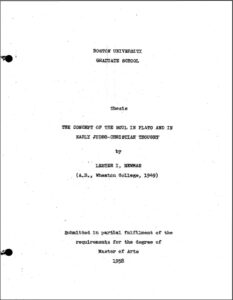
Lester I. Newman, The Concept of the Soul in Plato and in Early Judeo-Christian Thought, Boston University, Boston, MA, USA, 1958:
[Summary]
Chapter I: Introduction The purpose of this thesis is to study two great historical concepts of the soul and to show them to be, not only in marked contrast to one another, but also in strong opposition to one another. These two important historical concepts of the soul are; the Platonic concept , as found in the writings of Plato; and the early Judeo-Christian concept, as recorded in the canons of the Old and New Testaments. They represent two entirely different religious and ethical worlds; yet have come into contact with one another, have mingled together freely, and have greatly influenced one another. Certain of the very early Church Fathers saw the tremendous distinction between the Platonic concept of the soul and the early Judeo-Christian concept, and expressed strong opposition to the encroachment of the Platonic concept of the “soul” into the life and teachings of the early Christian community. These men, however, were replaced by other Church Fathers who employed Platonic philosophy to interpret Christian theology to the early Christian Church, a process still going on in this modern era. This thesis is concerned with a careful study of all the writings of Plato and to seek out from the original sources; themselves, exactly what Plato taught concerning the soul. In order to ascertain the true Platonic concept of the “soul,” in his writings have been studied according to the various periods of his writings. According to the eminent Platonic scholar, Lutoslawski, Plato’s writings can be divided into four very definite periods: the Socratic period, the first Platonic period, the middle Platonic period, and the latest Platonic period. The purpose of this thesis has been to study the use of the term “soul” in each one of the periods of his writings to determine how he commonly uses the word “soul,” how consistent he is in his use of the term, and how his use of “soul” in the latest of his writings compares with the earliest of his works. From this study, this thesis has sought to define the Platonic concept of “soul” from its most consistent, most common, and latest usage. This thesis has also been concerned with and equally meticulous study of the early Judeo-Christian concept of the term “soul.” In order to get an understanding of its usage in the early writings of the Jews and Christians, the canons of both the Old and New testaments were studied book by book. In the canon of the Old Testament, every occurrence of the Hebrew word for “soul,” nephesh, was studied in its context, and in the canon of the New Testament every occurrence of the Greek word for “soul,” psuche, was studied within its context. Certain related Hebrew terms were also studied, such as, ruach, neshamah, and leb to see their relatedness to nephesh. Also studied were certain related Greek terms to psuche, such as pneuma and zoe to ascertain their usage and their relatedness to psuche. It was found that these terms cannot be used interchangeably, for their meanings are very different.
Chapter II: The Platonic Concept of The Soul In the four periods of Platonic though: the Socratic Period, the early period, the middle period, and the latest period, a study of Plato’s usage of the term “soul” reveals that he uses “soul” in at least six philosophical ways: (1) “soul” used in an ethical-moral-philosophical sense, 308 times; (2) “soul” used in a philosophical-religious sense, 66 times; (3) “soul” used in an epistemological sense, 36 times; (4) “soul” used in a socio-politico sense, 17 times; (5) “soul” used in a metaphysical sense, 354 times; (6) “soul” used in an aesthetic sense, 19 times. There were a number of times when “soul” was used in such an obscure sense it was impossible to classify its philosophical meaning. The frequent use of the term “soul” and the many philosophical uses that Plato has for it, indicates its importance to Platonic thought. In fact, this study reveals that the metaphysics, the ethics, and the epistemology of Plato are based squarely on his definition of psuche. In light of Plato’s philosophical uses of the term “soul,” it is possible to define the term from its most common, consistent, and latest usage. Plato defines the soul as a simple, pure, unorganized, uncompounded, invisible, rational entity. He says that the soul is simple in its true nature and cannot be composed of many elements, that the soul is pure in its original, divine state, and that any impurity in the soul is from its contact with the earth. The soul is not visible, only to mind. It is rational, for it is that which true knowledge is concerned. Plato describes the soul as divine intelligence nurtured upon true knowledge. Plato, through usage, also defines the soul as pre-existent, supreme, and self-moving. Plato’s theory of knowledge is based upon the reminiscence of the soul of its former existence, for, to Plato, the soul is before all things and, has a first hand knowledge of the world of Pure Forms. Plato defines the soul, through usage, in still another way; as being immaterial, fixed, divine, indestructible, and immortal. Plato argues that the soul is of such and indestructible nature that not even evil can destroy the soul, for the soul, in its very essence, is immortal, and, hence, indestructible. Plato also maintains that souls are fixed, so that the number always remains the same; therefore, the soul must be immortal by nature. In this connection, he also stresses the simple, pure, uncompounded nature of this soul and its pre-existence before all things.
Chapter III: The Biblio-Judeo Concept of the Soul. The Hebrew word for “soul” is nephesh. This word is used over 700 times in the thirty-nine books of the canon of the Old Testament. Every occurrence of the word “soul in the Revised Standard Version is the Hebrew word nephesh, but with four exceptions: Psalm 57:8, 108:1, Proverbs 23:16, and Lamentations 1:20. The reader can know that he is reading the Hebrew word nephesh each time he reads the word “soul,” outside of the four mentioned passages, but what he does not know is that the word nephesh in over three hundred occurrences, is not translated “soul” but is rendered by over thirty different words and phrases, such as “life,” “breath of life,” “person,” “persons,” “self,” “heart,” “mind,” “creature,” and a host of other such words and expressions. Within the same verse nephesh will often be translated two or three different ways, making it extremely difficult for the average reader to know that the same terms is being used each time. If the term were translated consistently each time by the word “soul,” it would be possible for the English reader to come to a better understanding as to its definition by its usage, but, under the circumstances, this is very difficult, if not impossible. The careful reader of the Bible should have the right and privilege of coming to his own conclusions, determining his own definitions, and formulating his own doctrine as to the Biblical use of the term “soul.” This opportunity afforded the interested reader in this thesis, through the listing of all the occurrences of the Hebrew word for “soul,” nephesh, in the Old Testament of the Revised Standard Version. From a careful study of all 754 occurrences of nephesh in the Old Testament, the reader observes that the soul is to be defined by the following terms: (1) As being created a moving, living organism by God. This is in direct contrast to the uncreated, self-moving, unorganized Platonic soul. (2) As being the highest creation of God–the whole man. All moving, living organisms are souls, but the highest organism created by God is man. This created man, “soul,” is spoken of as being created a complex, compounded, rational, organized entity, in direct contrast to the Platonic simple, uncompounded, unorganized soul. The Old Testament canon also defines the soul, through usage, as being material substance, mortal, and destructible in nature, but also a candidate for resurrection and eternal life. This is in direct contrast to the immaterial, immortal, indestructible soul of Plato’s. The though of a bodily resurrection of life everlasting, through a might act of God, is also completely foreign to Platonic thinking.
Chapter IV: The Biblio-Christian Concept of the Soul The Greek word for “soul” is psuche. The word is used 111 times in the canon of the New Testament, following the manuscript Codex Vaticanus. In Revised Standard Version of the Holy Bible there is no other word, other than psuche, that is translated “soul.” However, the word psuche is not always translated “soul,” but, rather, in a great number of ways. Some of the words and phrases used to translate psuche, other than “soul,” are: “life,” “lives,” “mind,” “minds,” “persons,” “us,” and “human being.” Out of the 111 times that psuche is used in the New Testament, it is translated “soul” only forty times. The remaining seventy-one times the English reader is left uninformed that the word he is reading is the Greek word psuche. Since the translation of the Greek word, psuche, is done in so many different ways, it is of real help to the English reader to have a complete listing of each occurrence of psuche, as in this thesis. A study of them shows that psuche, from its usage, defines itself as being created a moving, living organism by God, the same as in the Old Testament. Usage also defines psuche as the highest creation of God–the whole man. This man is created, complex, compounded, material, organized, and rational. It is also mortal, subject to death, but is also a candidate for resurrection and eternal life through a mighty act of God. As can readily be seen, the definition of “soul” in both the Old and New Testaments are the same and in strong opposition to the Platonic soul.
Chapter V: The Platonic and Early Judeo-Christian Concept of “Soul” Compared and Contrasted. In the writings of the early Church Fathers, of the first two centuries of the Christian era, we find strong opposition to the Platonic concept of “soul” as it tried to creep into the theology of the early Christian church. They withstood the Platonic philosophy of the soul being subversive to the very essence of Christianity, with its doctrine of the natural immortality of the soul, as compared to the Christian belief of mortality of each soul and each soul in need of a bodily resurrection in order to obtain eternal life. Words and phrases which came into common use later in the history of the Christian church, were not used by the very early Church Father. We refer to such familiar terms as “the immortal soul,” “the immortal man,” “the never-dying soul,” “the deathless being,” “endless sin and misery,” “unending torment,” “the death that never dies,” and other such familiar expressions that clearly have their roots in Platonic thought. It is thought by many that the Platonic doctrine of the natural immortality of the soul came into the teachings and theology of the early Christian church naturally and easily, but this is not so, for the opposition was great to begin with from the early Church Fathers, whose keen insight saw that it was subversive to the basic doctrines of the Christian Church and that its philosophy belonged to an entirely different religious and ethical world. The chief media, for the entrance of Platonism into Christianity, was through the voluminous writings and great preaching of the Bishop of Hippo, Aurelius Augustine, in the fourth century. Augustine took Plato’s doctrine of the inherent immortality of the soul, disengaged it from the metempsychosis and transmigration and gained for it that general credence which it has held to this day.
Chapter VI: Conclusions. When Plato speaks of the soul, the thought of the immortality of the soul is always present, immortality being the natural endowment of the soul, due to its divine origin having been eternally pre-existent. All that is required of the soul, once it has entered the prison of the body, is to purify itself and set itself free from its bondage of the sense world and return back to its divine origin in the super-sensible world. The world of natural immortality, then, is its true home and its normal condition. The natural immortality of the soul was also the basis upon which Plato based his metaphysics, ethics, and his theory of knowledge. It lay at the heart of the Platonic concept of the soul. This study has also shown that the idea of the natural immortality of the soul is completely foreign to the use of nephesh and psuche in the Bible. Here on reads that the soul was created out of dust by its Creator and returns to dust at its death. The very fact that God called the first man Adamah, “earth-made,” indicates the earthly nature of the Biblical soul, as contrasted to the heavenly origin of the Platonic soul. If man was made a living soul by his Creator out of dust and the “breath of life,” and if at death he returns to the ground from whence he was taken, and his “breath” (spirit) goes back to God from whence it came, then it must be necessary for the two to be reunited in order that man might live again. Not only resurrection, but resurrection of the body for life everlasting, is central to the teachings of the Christian faith. The thought of a bodily resurrection to life everlasting is completely foreign and unnecessary to Platonic thought. It is at this point that the two great concepts of “soul” meet and forever part company.
(The Boston University Institutional Repository [https://open.bu.edu/] contains documents and publications authored or co-authored by BU faculty, students, and staff. The entire thesis [whose summary is above] is available in https://open.bu.edu/handle/2144/6233).
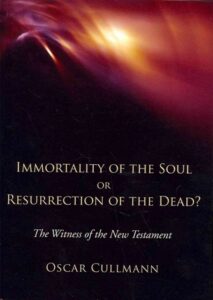
Oscar Cullmann, Mélanges offerts à KARL BARTH à l’occasion de ses 70 ans, Reinhardt, Bâle, 1956. (In French: Immortalité de l’âme ou résurrection des morts?; in English: Immortality of the Soul or Resurrection of the Dead? The Witness of the New Testament, Epworth Press, England, 1958. This cover is from 2000 edition, Wipf & Stock Publishers, Eugene, Oregon, USA):
If one recognizes that death and eternal life in the New Testament are always bound up with the Christ-event, then it becomes clear that for the first Christians the soul is not intrinsically immortal, but rather became so only through the resurrection of Jesus Christ, and through faith in Him. It also becomes clear that death is not intrinsically the Friend, but rather that its ‘sting’, its power, is taken away on/y through the victory of Jesus over it in His death. And lastly, it becomes clear that the resurrection already accomplished is not the state of fulfillment, for that remains in the future until the body is also resurrected, which will not occur until ‘the last day’…
The answer to the question, ‘Immortality of the soul or resurrection of the dead in the New Testament’, is unequivocal. The teaching of the great philosophers Socrates and Plato can in no way be brought into consonance with that of the New Testament. That their person, their life, and their bearing in death can none the less be honoured by Christians, the apologists of the second century have shown.
– Excerpts from Introduction and Conclusion. See here a “compact edition” in Portuguese.
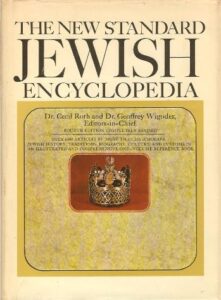
The Standard Jewish Encyclopedia, Cecil Roth (Ed.). Doubleday & Company, Inc., New York, USA, 1959 (This cover is from The New Standard Jewish Encyclopedia, Virgin Books, 1970):
IMMORTALITY OF THE SOUL: In religion, the direct belief in a continued existence after death; in philosophy, the idea that there is some part of the human personality the eternity of which can be proved or at least made acceptable to reason. Primitive religions generally consider life as whole and indivisible; their concept of an after-life therefore refers to the personality as a whole and not to the SOUL in the narrower sense. The dead exist in a state of lowered vitality; this kind of bleak shadow-life in the underworld was known, for instance, to the Greeks (Hades) and the ancient Hebrews (Sheol). When the spirit of life has departed, man continues to exist in the land of the shadows, but “the dead praise not the Lord, neither any that go down into silence” (Ps 115:17). On the other hand the soul is regarded as an immaterial substance whose relation to a particular body is more or less incidental. According to this view, existence before birth and after death is a matter of course and it is the soul’s descent into matter and the mortal body that requires explanation. The moral and religious task of life it then to protect the soul from losing its purity while in the material world. These ideas were already current in Hellenism and appear as commonplaces [or: cliches] in rabbinic literature. A further possibility within this range of ideas is METEMPSYCHOSIS. Another approach to immortality, preserving the older conception of life as a totality of body and soul, is manifest in the belief of the RESURRECTION of the body, which became an article of faith in Judaism and was incorporated into Maimonides’ 13 Articles. The conflation of the two kinds of belief yielded the traditional Jewish concept of a Hereafter where the departed souls are rewarded (paradise, garden of Eden, etc.) and the wicked punished (hell, Gehinnom) for their deeds in this life until the great day of the Resurrection when the final judgment will be followed by a completely new era (olam-ha-ba).
SOUL: The biblical expressions denoting s. (nephesh, ruah, neshamah) all understand life as the animation of the body and derive from roots meaning “wind,” “breath,” etc. (cf. Gen. 2:7); after death there is merely a shadowy existence in the underworld (sheol). Only in the last century BCE did the soul-body dualism and the concept that the s. was an independent substance joined to the body gain general credence; the s. originates in heaven and descends to earth, joining a material body at the moment of conception or birth and losing its original perfection. This dichotomy, fully developed in hellenistic literature (Philo, etc.), is also accepted by the Talmud where it is said that all s.’s exist from the creation of the world and are stored in heaven until their time comes to join the bodies destined for them. The rabbis do not merely equate s. and body with good and evil; it is always the s. which sins and not the body. In medieval philosophy the main problem concerning the s. was that of IMMORTALITY. The Neoplatonic tradition which assumed an independent spiritual soul-substance could entertain a belief in immortality more easily than the Aristotelian philosophers for whom s. was the “form” of the organic body. Maimonides and other Jewish Aristotelians assumed that only that part of the s. which man develops by his intellectual efforts (the “acquired intellect”) is immortal; other thinkers defined the s. in such a way as to extend immortality also to non-philosophers. Kabbalists generally accepted the belief in METEMPSYCHOSIS (gilgul). The desire to express one’s love for departed s.’s and, if possible, to improve their lot in the hereafter has given rise (to a large extent under non-Jewish influence) to various rites, some of which (e.g. YIZKOR, HASHKAVAH, KADDISH) have become permanent features of the synagogue service.
– Revised Edition, 1966, Cols. 955, 956 and 1743.
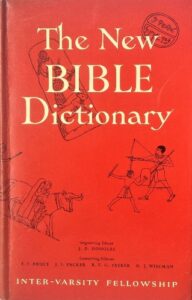
J. D. Douglas, The New Bible Dictionary, Inter-Varsity Fellowship, London, 1962:
1. Inherent in ‘life’ (hayyim) is the idea of activity. Life is ‘that which moves’ (Gn.7:21 f.; Ps.69:34) in contrast to the relaxed, dormant, or inert state of non-life. Running water is ‘living’ (Gn.26:19), and rapid labor in childbirth indicates the mother’s ‘aliveness’ (Ex.1:19). The word’s frequently used plural form emphasizes the intensity of the concept. Life is associated with light, gladness, fullness, order, and active being (Ps.27:1; Jb.33:25 ff.; Pr.3:16; Gn.1) and contrasted with the darkness, sorrow, emptiness, chaos, and silence which are characteristic of death and inanimate being (Ec.11:8; Ps.115:17).
2. Soul (nepes), as ‘being’ or ‘self,’ is common to man and beast, living and dead (Lv.21:11; Job.12:10). But its meaningful state is ‘living soul’ (nepes hayya, Gn.2:7) and, therefore, may simply mean ‘life.’ To die is to breathe out one’s soul, and to revive is to have it return (Je.15:9; 1Ki17:21); or, seated in the blood, it is ‘poured out’ at death (Lv.17:11; La.2:12; Is. 53:12). … ‘life’ and ‘self’ are so closely parallel that to lose one’s life means literally to lose one’s self (Pedersen, Israel, I, 1926, 151 ff.; Jb.2:4; Ezk.18).
3. Similarly, spirit (ru’ah) or breath (nesama), as the principle which distinguishes the living from the dead, often may be rendered life (1 Sa.30:12; Jb.27:3 f.). To die is to lose one’s breath or spirit (Jb.27:3; Ps.104:29f.); to revive is to ‘have it come again’.
4. Life is given to man as a psycho-somatic unity in which ‘our own distinctions between physical, intellectual, and spiritual life do not exist’ (von Allmen, pp. 231 f.); and the Old Testament view of man my be described as ‘animated body’ (Robinson, p.27). Thus soul may be paralleled with flesh (Ps. 63:1), life (Jb.33:28), or spirit (Ps. 77:2f.), and all terms viewed as the self or ‘I’. It is the ‘I’ which lives – and which dies (cf. Gn.7:21; Ezk.18:4).
– p. 735.
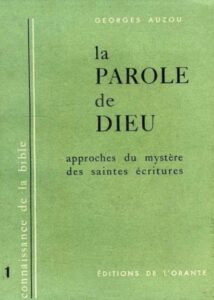
Georges Auzou, La Parole de Dieu. Approches du mystère des Saintes Écritures, Editions de l’Orante, Paris, France,1960:
Le concept d’‘âme’ au sens d’une réalité purement spirituelle ou immatérielle, distincte du ‘corps’,… n’existe pas dans la Bible.
– p. 128.
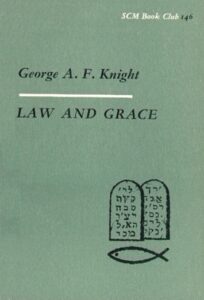
George Angus Fulton Knight, Law and Grace: Must a Christian Keep the Law of Moses?, SCM Press (Series: Religious Book Club 146), London, England, 1962:
In the Old Testament man is never considered to be a soul dwelling in a body, a soul that will one day be set free from the oppression of the body, at the death of that body, like a bird released from a cage. The Hebrews were not dualists in their understanding of God’s world.
– p. 79.
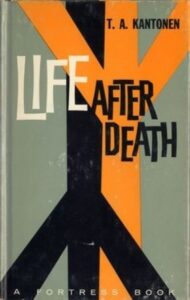
Taito Almar Kantonen (1900-1993), Life after Death, Fortress Press, Philadelphia, USA, 1962:
Since Neoplatonism was the prevailing spiritual philosophy during the formative period of Christian theology, it is not surprising that many of the Fathers identified the Christian doctrine of eternal life with Platonic immortality. Through the centuries this unscriptural belief continued to permeate Christian thinking and to weld itself with popular animism into such an apparently self-evident and formidable “truth” that it seemed to be a veritable cornerstone of the Christian faith. In the Fifth Lateran Council (1512-17) the Roman church indeed proclaimed it to be an official dogma of the church. The Reformers were content with the ancient creeds which teach the “resurrection of the body,” not the “immortality of the soul.” But so firmly has the latter belief become imbedded in the Protestant mind too that the theologian or the minister who is led by Scripture to reject it is thought to be blasting the rock of ages. Thus when the Swiss scholar Oscar Cullmann, known for his profound interpretation of the New Testament and his positive Christian convictions, published a study in which he pointed out the contrast between the Greek conception of the immortality of the soul and the Christian doctrine of the resurrection of the dead, he aroused a storm of protest. He was accused of being a monster who delights in causing spiritual distress, one who offers stones, if not serpents, to people hungering for the bread of life. In the preface to the recent English translation of the study (Immortality of the Soul or Resurrection of the Dead?) Professor Cullmann states that no critic has even attempted to refute him by scriptural exegesis, which is the whole basis of his presentation, and pleads with his readers to listen to what Scripture has to say. We cannot expect to grasp the Christian view unless we are willing to listen to Scripture even when it contradicts our own cherished wishes and traditional opinions… Man does not have a mortal part, the body, and an immortal part, the soul. He is an indivisible unit, a body-animated-by-soul. As such, whether viewed under the body-aspect or the soul-aspect, he exists solely by his relation to God.
– pp. 14, 15.

